As a digital marketer, I’ve had my fair share of trials and errors when it comes to understanding and leveraging search intent for optimal content creation. Let me take you through my journey of realizing just how crucial it is to align what your audience is searching for with the content you produce. It’s not just about keywords anymore; it’s about understanding the user’s mindset and catering to it specifically. Here’s what I’ve learned about SEO search intent.
TL;DR: Understanding how to match search intent is vital for effective content creation. This guide covers how to align your content with user queries, especially for local businesses, using practical examples and insights from my own experience.
I often find myself captivated by the nuances of search intent. So, let’s break it down together. What exactly is search intent? In simple terms, it refers to the reason behind a user's online search. When someone types a query into a search engine, they're inherently looking for something. Grasping this intent is crucial for anyone involved in creating content or managing a website. A clear understanding about SEO can make or break your visibility online. After all, if you don’t align your content with what people are searching for, are you really meeting their needs?
Search intent is essential to effective SEO strategies. If you misunderstand it, you might produce content that isn't relevant. This leads to lower click-through rates and diminished engagement - all bad news for your online presence. As Ron from Osborne Digital Marketing highlighted, a mismatch in search intent can push your content down in search rankings. We know how vital it is to rank high; right?
Now, let's discuss the different types of search intent. Broadly, it can be categorized into three main types:
Understanding search intent directly shapes your content strategy. For instance, if you’re targeting transactional intent, your content should focus on compelling calls to action. This means presenting your services clearly and enticingly. On the other hand, if the intent is informational, your approach should lean towards educational materials - perhaps providing in-depth blog posts about roofing options or maintenance tips.
As Ron emphasizes, reviewing the search engine results pages (SERPs) is a smart move. Scanning the top results can give you hints about what the searchers are looking for. Do you see local service ads? If so, shift your content to engage with those users who are ready to spend. In cases where informational content appears, it may be beneficial to craft thorough guides or articles that answer common questions.
In a nutshell, aligning your strategy with search intent isn’t just beneficial - it's essential. If you want to succeed in this digital landscape, take the time to understand your audience's needs and preferences. They will guide you toward becoming a trusted source of information.

Google's algorithm has changed more times than we can count. And with each update, it becomes more intricate. Initially, it relied heavily on keywords. Simple, right? But as time passed, things got trickier. We saw the rise and importance of backlinks, user experience metrics, and content relevance. In fact, now it even assesses the context behind your search queries.
At first glance, you might think that means better results. But there’s a catch; the complexities can lead to unexpected outcomes. I mean, have you ever wondered why you typed “best pizza” but got results for gluten-free options instead? That’s Google trying to predict what you might want based on historical data. It's both fascinating and baffling!
These examples reflect the challenging landscape of Google's intent matching. Sometimes the unexpected can even outshine the expected results, thanks to how algorithms prioritize certain content types. This leads us to what happens when platforms like Reddit come into play.
Now, let's talk about Reddit. I remember Ron from Osborne Digital Marketing mentioning how unexpectedly high it ranks on certain queries. If you think about it, it makes sense. Reddit is a hub of discussions, providing real user insights - something Google's algorithms are hungry for.
When someone asks a question on Reddit, they get real, candid answers. Since Google strives to deliver relevant, quality content, it looks at such community discussions as valuable resources. Who knew that a forum could take the spotlight over a well-optimized business page? It’s a game changer. Think of it as the David and Goliath of search results - sometimes, the underdog unexpectedly wins!
If you want to stay ahead, you need to keep such shifts in mind. Our approach towards SEO should evolve, focusing on community-driven insights and collaboration. This is how we can align our content with what users truly seek, allowing us to stand out in the cluttered SERPs.
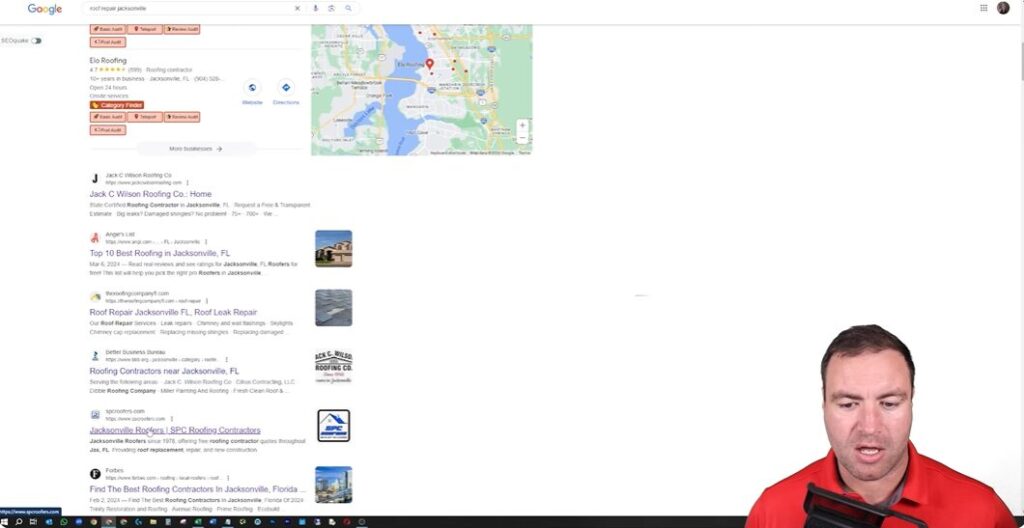
When it comes to creating effective content for search engines, understanding search intent is crucial. But how do we bridge that gap? Let’s explore some practical steps that help match search intent more effectively.
First, we need to look at the SERPs (Search Engine Results Pages). They can reveal a lot about what users are looking for. For instance, if you search for something and see a variety of links along with different content types, what does that mean? It might indicate diverse user intent. I often think of SERPs as a roadmap - they guide us toward understanding what people truly want.
Here are some indicators to watch for:
Have you noticed the map pack in your search results? This small box often contains local businesses related to your query. When I see a map pack, I think: "This is commercial." Why? Because the presence of a map pack indicates that users may want to find local services.
If you’re a business owner, this is your cue. It’s time to craft content aimed at conversions instead of just providing general information. Map packs indicate that people are ready to choose a service, which directs your content to highlight offers, customer testimonials, or contact information prominently.
Choosing between commercial and informational content depends on what you observe in search patterns. For example, if your query is "roof repairs in Jacksonville," and the map pack appears, focus on conversion-driven content that discusses your services. This aligns your business with what users are actively seeking.
On the flip side, if the search is more informational, adjustments should be made. Take a query like "Jacksonville roof repair cost." Even without a map pack, this suggests an opportunity to create valuable blog posts or guides. Dive into topics that relate to costs, materials, or tips on choosing the right service.
As Ron from Osborne Digital Marketing puts it, "Crafting dedicated blog posts to address specific client concerns instead of mixing commercial content pages with informational articles is essential."
In summary, always scrutinize the organic search results and adjust your content strategies based on what you find. By recognizing whether the intent is commercial or informational, we can create targeted content that resonates with our audience. Ultimately, the goal is to align our content with the needs and desires reflected in the SERPs - which is, after all, the heartbeat of effective SEO.
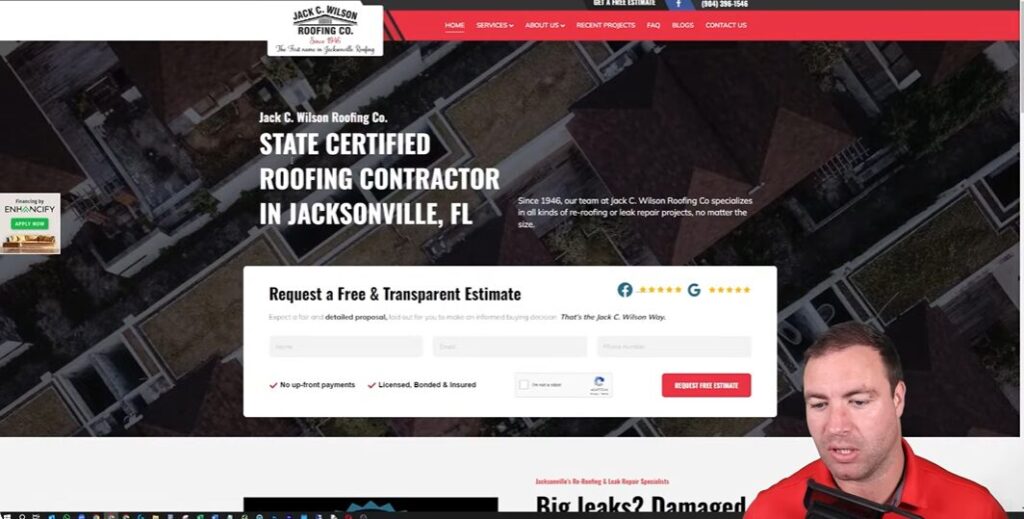
When it comes to roofing services, the right keywords can make or break your online visibility. I often leverage SEO search intent strategies to fine-tune how roofing businesses, especially in Jacksonville, reach their audience. It's not enough to just stuff pages with keywords. You have to understand what people are truly searching for and why.
Let’s learn about how to match search intent strategies specifically for roofing businesses. First, I assess the search results. When I type in keywords like "roof repairs in Jacksonville," the map pack appears. This tells me the intent behind the search is primarily commercial. People are likely looking for services to hire. Therefore, I focus on creating content that drives conversions rather than just informative articles.
Different keywords can signal vastly different intents. For example, if someone searches for "Jacksonville roof repair cost," it indicates they are looking for pricing information. In this case, I focus on creating educational content that outlines various factors affecting costs, rather than directing them to a specific service. This creates an opportunity to answer their questions.
When I see queries that pop up in the “people also ask” section, I make a note. These often lead to more keyword opportunities that I can explore in blog posts or guides. The goal is to match the nature of the content to the intent of the searcher.
From my analysis, I've learned a few key takeaways:
Understanding these nuances can help you tailor your SEO strategy effectively. After all, the right content can attract the right customers, ultimately leading to better conversions. It's fascinating how a simple keyword can open a floodgate of opportunities if you know how to interpret it correctly.
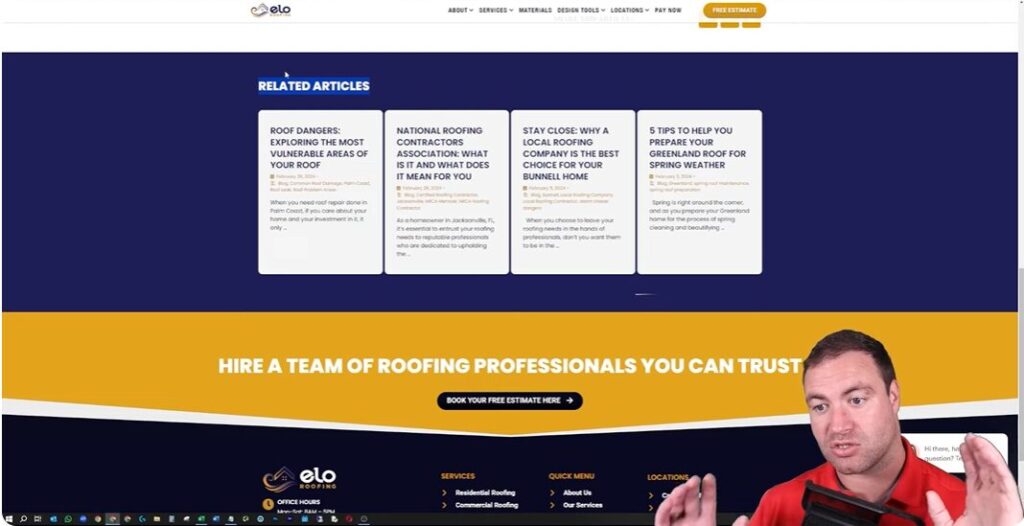
When creating content, it’s essential to understand user intent. Why? Because a well-structured piece can mean the difference between getting lost in the vast ocean of the internet or landing right in front of the audience who needs it. I believe that user-friendly content organization leads to a better experience, making it crucial to prioritize clarity in our writing.
Have you ever opened a page and immediately felt overwhelmed? I know I have. A chaotic layout can frustrate readers and drive them away. User-friendly organization helps to keep your audience engaged. This can be achieved by:
Think of it like a well-organized bookshelf. If each book is easy to find, you’re more likely to dive into reading. So, let’s make our content just as accessible!
Another aspect I find invaluable is leveraging tools like Page Optimizer Pro. It provides insights that can guide content structure. By using data-driven analysis, we can discover what elements lead to higher engagement rates. These insights help in identifying which formats resonate best with readers.
For instance, if I discover that lists or tables are popular among my target audience, I’ll be more inclined to use them. This tool helps in matchmaking between content and the needs of the user. After all, who doesn’t want to serve up exactly what their audience is craving?
Finally, it's worthwhile to look at what the top-ranking pages are doing. When I analyze successful formats, I often find that they adhere closely to users' needs and preferences. This might mean:
Consider this: if the top competitors use rich snippets, diagrams, or embedded videos, it might be a sign to enhance our own content with similar or better features. Drawing on these benchmarks allows us to not only compete but also excel in delivering value.
By focusing on how we structure our content, we can truly align with the intent of our users. It's not just about ranking high; it's about meeting the needs of the people searching. I find that this alignment is paramount for digital success.

As we navigate the digital landscape, I find it vital to recognize the shifting trends in search algorithms and user behavior. With tools like Rank Lightning coming to the forefront, we have an incredible opportunity to fine-tune our SEO strategies. But what do we need to be aware of?
So, where does this leave us in terms of SEO practices? Here’s what I think. The future of SEO marketing is about adaptation and understanding. Gone are the days of simply stuffing pages with keywords. Instead, we need to be intuitive.
"To win in this game, it’s all about how to match search intent with valuable content." - Ron from Osborne Digital Marketing
For businesses, the implications are significant. I believe that SEO must now blend seamlessly with marketing strategies. Here’s how:
As I look toward the horizon, it’s clear that staying relevant is a continuous journey. Regularly researching competition and analyzing search results will be paramount.
When examining results, I often seek to identify whether searches are commercial or informational. This understanding can guide our content strategy significantly.
In an environment that’s always changing, are you prepared to adapt? If we can stay ahead of the curve, we’ll not just survive but thrive. The message is clear: adapt or get left behind.
As I wrap up this discussion on SEO search intent mastery, let’s take a moment to dissect how aligning our content with user needs is absolutely vital. When we talk about how to match search intent, we’re looking into the very heart of SEO. It’s not just about keywords but understanding what users truly seek. If we miss the mark, we risk losing visibility and, ultimately, engagement.
Think about it: when someone searches for “roof repairs in Jacksonville,” they’re likely looking for local services. In this case, your content must guide them toward a decision-making point. It's about meeting their needs right where they are. If we simply provide informational content instead of driving them toward conversion, we might as well be shouting into a void.
I wholeheartedly encourage you to leverage tools that provide SEO insights. Tools like Rank Lightning - which I’m excited to launch soon - can offer valuable data on keyword performance and competitive analysis. Additionally, software like Page Optimizer Pro can help pinpoint what content resonates with users. By implementing such tools, we can fine-tune our strategies and aim to align our offerings with what users are genuinely looking for.
Now, here’s a thought: when was the last time you evaluated your content strategy? Look at what types of content you’re producing and consider the search intents behind them. Are you focusing too much on one aspect - like education - while bypassing the commercial side? Or vice versa? It’s essential to balance these elements to cater to all types of users.
In essence, the takeaway here is clear. Aligning your content with user needs, utilizing the right SEO tools, and continuously evaluating your own strategies are crucial for success. So, let’s commit to mastering search intent and creating content that not only attracts clicks but also converts. After all, it’s about meeting users where they are and guiding them on their journey. It’s time to make your content work harder for you!
When I first ventured into the digital marketing space, I found myself asking, "How can I connect my local business to the community?" Little did I know, the answer lay in the simple yet potent world of local backlinks. Today, I'm eager to share some juicy secrets that have helped me on how to get local SEO backlinks, and many businesses thrive!
TL;DR: Discover how local backlinks can elevate your business's online visibility, including practical strategies and creative methods to acquire those vital links in your community.
When I started getting into the world of Search Engine Optimization (SEO), one thing became crystal clear: local relevance matters. A lot. Why? Because in today’s digital age, users are looking for localized information. Think about it. If I search for “best pizza near me,” I don’t want results from New York when I’m sitting in Los Angeles. I want local, relevant results. This is where local backlinks come into play.
Local backlinks signal to search engines like Google that your business is a player in the community. They not only enhance visibility but also align your business with local relevance. Google analyzes these connections to determine if your business is indeed part of a particular area. This is why I tell business owners - focus on building those local backlinks!
Google’s algorithms are designed to prioritize trust and credibility. So, when acquiring backlinks from local websites, think of it as a vote of confidence. For instance, if a local newspaper links to your roofing company’s blog post, it’s like a stamp of approval. Google sees this and says, “Wow, this roofing company is relevant to Tampa!” There are a lot of known effective strategies for good roofing business SEO.
One of the tricks I love to use is conducting a backlink gap analysis. This means looking at the backlinks of competitors. What are they doing right? Where are they linking? Sometimes a local directory that lists your competitors can also regard your business. Explore local partnership opportunities with non-competing local businesses. It’s a win-win situation for both parties!
Now, let’s differentiate between generic and local backlinks. Generic backlinks can come from any source, anywhere in the world. They don’t take into account your location. Sure, they add to your overall backlink profile but they lack specificity.
On the flip side, local backlinks are tailored to your geographical area. They often come from local blogs, directories, or news sites. For example, a link from a Tampa Bay business directory is worth more for a Tampa-based company than a link from a national blog. This is the crux of local SEO strategy.
In my research, I came across the technique of using search operators. For instance, typing “Tampa businesses” within quotations in Google reveals local business directories and resources. Plus, I discovered the usefulness of tools like Hexo and the SERP Scraper Chrome extension to streamline this process. They help you gather potential backlink sources effectively.
In conclusion, building local backlinks requires creativity and outreach. By investing time and effort into local link-building strategies, we can significantly improve our online visibility and credibility.

When I think about local SEO, I often ask myself: how can I stand out in a crowded digital space? One of the key strategies I've discovered revolves around uncovering local opportunities, particularly through the use of geo locations. Let’s explore how to harness this power effectively.
Search operators are like magic wands for digital marketers. They help us find treasures hidden in the vast realms of the internet. For instance, you might use a simple technique by enclosing certain phrases in quotation marks. Try searching for “Tampa businesses” on Google. What do you get?
By using this method, you’ll discover a whole host of local directories and resources. These directories can serve as excellent sources for backlinks. Remember, keywords matter. I’ve found it helpful to incorporate phrases like “Tampa Bay business listings” to get even more relevant results. This approach enables us to connect directly with local entities that are relevant to our business.
Understanding where to list your business is crucial. I'm talking about local directories specific to your industry. Think about platforms like Yelp, Yellow Pages, or even niche directories tailored to your service. Imagine a roofing company in Tampa - the right directories could greatly enhance its visibility.
By establishing a solid presence in key local directories, we signal to search engines that we are relevant in a specific geographical area, ultimately improving our rankings.
Data gathering can be tedious, but there’s a solution! Enter scraping tools, like Hexo or the SERP scraper Chrome extension. These tools can streamline the process of gathering long lists of potential backlink sources. With just a few clicks, you can extract valuable information from search results. It’s like having your own personal assistant!
I always say, "Work smart, not hard!"
By leveraging these scraping techniques, we can compile an extensive database of local businesses to connect with. This can open the door for potential collaborations that can benefit both parties.
Incorporating local SEO strategies, utilizing search operators, and employing effective tools can significantly enhance your online presence. Local opportunities are everywhere - just waiting to be discovered!
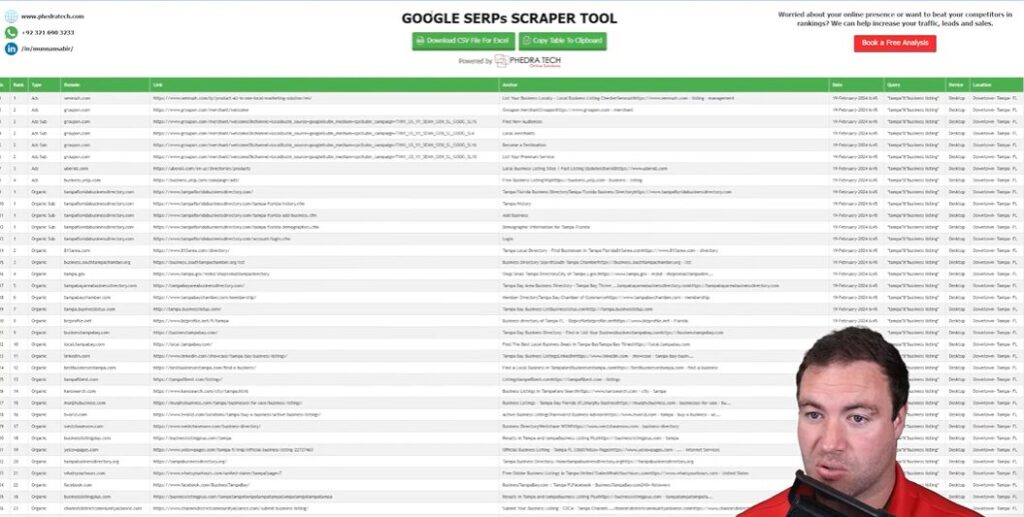
I've found that analyzing competitors’ backlinks can be a game changer for anyone looking to enhance their link building strategy. Why reinvent the wheel? Instead, we can take a peek at what others are already doing and learn from their successes and failures. Let’s explore how we can use competitor backlinks as a guiding light for our own efforts.
When I’m diving into competitor analysis, I often start by identifying a few key players in my niche. This might mean looking at local businesses or even bigger companies that operate in the same space. Here’s how I approach it:
By focusing on these aspects, we can uncover excellent opportunities to acquire backlinks. Think of it as a treasure map, where the X marks the spots that are ripe for our own business.
Local businesses often have unique positioning and opportunities. I’ve realized that examining local links, especially, opens doors we might not have considered. For example, Ron from Ausbon Digital Marketing emphasizes that "not all backlinks are equal." This is particularly true in local SEO.
Many times, your rivals might already have partnerships with relevant local directories or organizations. By understanding where competitors are getting their local backlinks from, we can tap into similar sources.
Lastly, let’s talk about collaboration on how to get local SEO backlinks. It's vital! In my experience, reaching out to non-competitive businesses still relevant to my niche can be highly rewarding. For instance, if I’m a roofing business, I might contact local home remodelers to collaborate on content.
This creates a perfect situation - by doing something beneficial for both parties, we secure backlinks without direct competition. Remember, it’s all about building relationships, which can lead to mutually beneficial linking opportunities.
“Establishing relationships with other local businesses can enhance your backlink profile while also opening doors for future collaboration.”
So, if you haven’t yet, give competitor analysis a go. The insights gained can profoundly impact your link building strategy. It’s truly an effective way to stay ahead while building a robust online presence.
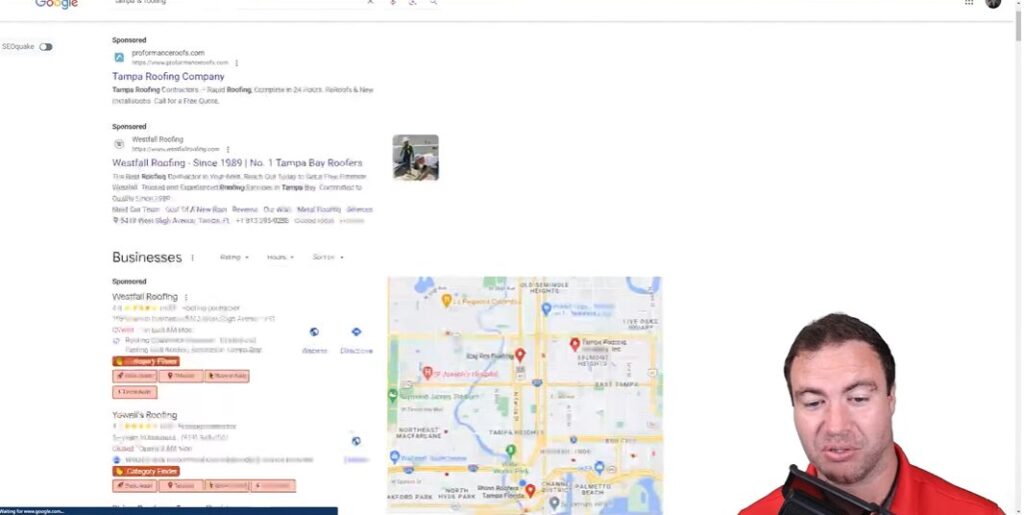
When it comes to local SEO, backlinks are vital. They signal Google that your business holds relevance in a specific location. But how do we get these local backlinks? It starts with smart outreach. Let me share my approach on how to do this effectively.
First off, we need to connect with businesses that complement our own. This means looking for not direct competitors but those who can benefit from our services or products. For instance, if you run a roofing company, consider reaching out to local remodeling companies. They can mention your services in their content, and in return, you get a valuable backlink.
Why is this important? Think about it. A remodeling company has customers who might also need roofing services. The relationship is mutually beneficial. Plus, when we connect with these complementary businesses, we strengthen our local network.
Now that we've identified potential partners, it’s time to pitch our collaboration. A successful pitch must clearly explain how both parties will benefit.
For example, in our roofing scenario, I could say, “By mentioning our roofing services in your next blog, we both can attract clients who might need additional renovations.” This approach tends to grab attention since it shows clear advantage.
Once you’ve landed some backlinks, don’t stop there! Building lasting relationships is key. Networking isn’t just about collecting backlinks; it’s about creating a community. This can lead to more collaboration opportunities down the road.
Here are some tips to keep these relationships thriving:
Just like any relationship, mutual support and communication strengthen these partnerships over time. Remember, your goal isn’t just to acquire backlinks; instead, think of it like building a collaborative network. This will foster growth and trust in your local community.
In conclusion, local backlink outreach isn’t just about making connections; it's about creating something that benefits everyone involved. Adopting this mindset can make all the difference in your local SEO strategy!
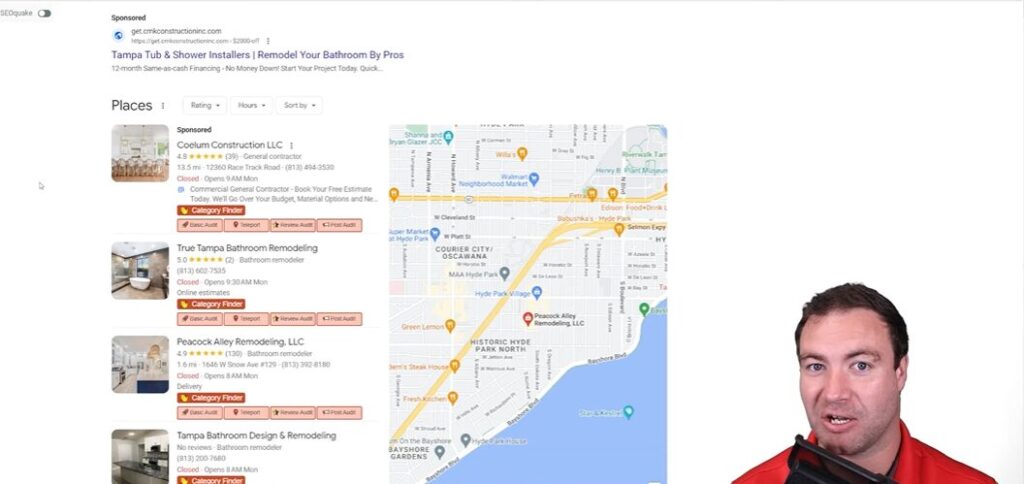
In the world of SEO, especially local SEO, the right tools can make a big difference. I’ve learned that focusing on local backlinks is like having a map for your business location. It shows Google where to find you, enhancing your visibility in localized searches. Here’s a breakdown of some effective tools and techniques you can use.
Let’s start with SEO tools. Not all backlinks are created equal. It’s essential to focus on local, relevant backlinks to improve your online presence. Think about it - if your business is a roofing company in Tampa, Florida, you need backlinks that showcase your local relevance.
It’s about making your life easier, right? So why not take the time to master these tools? They can save hours of tedious work and streamline your outreach efforts.
I have often relied on Google search operators to find local backlink opportunities. A simple technique I love involves using quotation marks. For instance, searching for “Tampa Bay business listings” yields localized directories. This strategy helps to find those hidden gems that can boost your backlink profile.
Imagine finding a local remodeling company to collaborate with. You can share content that mentions each other’s businesses, resulting in valuable backlinks without competing directly.
Now let's talk about outreach. It can be exhausting, right? That’s where automation comes in.
By automating, you'll free up your time for strategic thinking instead of getting lost in mundane tasks. How great is that?
In conclusion, utilizing these tools and techniques is key. The more you simplify your process, the more time you save for what truly matters: growing your business.
As I wrap up our journey into local SEO strategy, I can't help but feel excited about the possibilities. But how do we tie everything together in a way that works? The answer lies in a combination of community engagement, building relationships, and being adaptable.
First, let’s address the role of backlinks in local SEO. Backlinks are not just links but bridges connecting different parts of the internet. When they come from local, relevant sources, they signal to Google your geographical presence. That’s crucial. Remember the roofing company in Tampa I mentioned? Without its local backlinks, Google might not recognize its service area. Thus, to engage the community effectively, we need to think about how we can acquire these local backlinks. So, how do we do this?
One approach is to seek collaborations with local businesses. For example, if you're a roofer, why not collaborate with local remodeling companies? Create engaging content together. You could share a blog post about the benefits of quality roofing in home renovations. They mention your services, and voila, you get that valuable backlink. This not only enhances your online visibility but fosters community engagement. A win-win!
Next, let’s reflect on the importance of maintaining relationships with local businesses. Building a strong network doesn’t happen overnight. It takes time and effort. But consider this: each relationship can open doors. Perhaps a local coffee shop can host your flyers or mention you in their newsletters. Strong community ties provide trust and credibility.
Don’t forget about attending local events. They’re golden opportunities to meet new business owners. Every connection could potentially lead to a backlink or referral. I often say, “Networking is like tending a garden; with patience and care, it blossoms over time.”
Lastly, let’s talk about the need to be flexible with our local SEO strategies. The internet evolves constantly, and so do search algorithms. What worked yesterday may not work tomorrow. That’s why I believe in continuously updating our SEO tactics. Look at the data. What’s working? What’s not?
For instance, tools like Hexo or SERP scraper can help us analyze backlink opportunities. These analytics will guide our strategies and show us where to adjust our focus. Knowledge is power! To stay ahead, we must keep learning and adapting on new strategies on how to get local SEO backlinks.
In conclusion, a strong local SEO strategy is built on solid backlinks, vibrant business relationships, and a readiness to innovate. As we look to the future, let’s embrace these elements. Every small effort counts. Always remember, the local community is not just a market; it’s a space of collaboration and growth. Together, we can elevate our visibility and thrive. Are you ready to take the next step?
When I first began to understand the world of SEO, I faced the daunting task of finding clients who truly valued what I had to offer. I remember sending out countless generic emails, only to be met with the dreaded silence of the digital void. It wasn't until I discovered the power of strategic client hunting that everything changed for me. This post is a culmination of those lessons learned, crafted for anyone looking to boost their client acquisition game. This article talks about effective tips and tricks on how to get SEO clients.
TL;DR: Learn how to effectively hunt for SEO clients by building credibility, providing value, and using strategic outreach methods that go beyond the spammy tactics.
During my journey, I have learned that a personal brand is more than just a logo or a catchy tagline. It's how you present yourself to the world to attract the right SEO clients. It's your story, values, and what sets you apart from others. Think about it: when people see your name, what do they think? What emotions does it evoke? A strong personal brand can open doors and create opportunities.
My path wasn't typical. I started in the telecom industry, where I hustled my way to success. But as I watched the digital landscape evolve, I felt the call to shift my focus to SEO. The transition was daunting. I had to learn new skills, understand the nuances of search algorithms, and adapt to a constantly changing environment. Challenges? Of course. But each hurdle taught me valuable lessons.
In today's digital age, standing out is crucial in order to close deals with SEO clients. The market is saturated with experts and self-proclaimed gurus. So, how do you establish credibility?
For instance, in every email I send, I include a success story. Perhaps I helped a local roofing company climb to the top of Google’s rankings. That success builds trust.
One effective way I've built my brand is through storytelling. As Ronald Osborne, I often share my wins - like when I ranked a struggling client's website. It’s not bragging; it’s proof that my strategies work in most types of clients and businesses. A potential SEO client wants to know: can you deliver? And I show them that I can.
Social media has become a vital tool in building my personal brand as an SEO agency. It's where I connect with my audience. Platforms like LinkedIn, Twitter, and Instagram allow me to share insights and successes. I am not just selling services; I'm building relationships. I often ask, “How can I help?” This inquiry opens the door for deeper connections. For businesses and agencies, it is important to build your social media presence starting with essential marketing content that captivates the attention of your target market.
Finally, here's what I’ve learned about creating a relatable persona:
Even when I make mistakes, I own them. I think, "Who's perfect anyway?" This openness makes me more relatable. Even an expert in SEO business thinks this way.
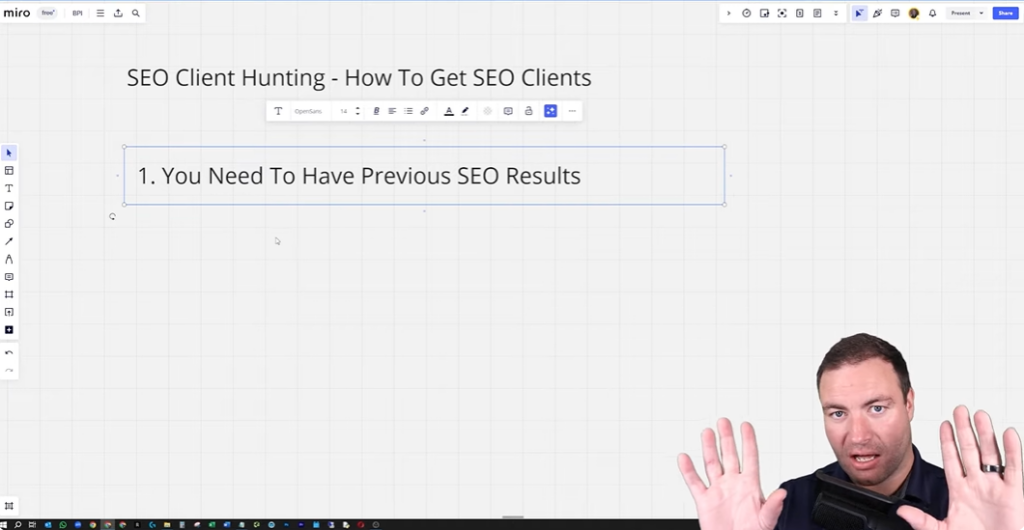
When it comes to attracting new SEO clients, results matter far more than sending out bulk cold emails. Trust me, I've been there. It's tempting to blast your offer to thousands, but that rarely leads to meaningful connections. Instead, focus on the results you've achieved - they speak volumes about your expertise.
Think about it: Would you choose a service based solely on a random cold email? Or would you prefer to see proof of past successes? Potential clients want to know what service you can do for them. So, showcasing your results, such as proof of past SEO projects ranking on the first page of Google search results and having a strong online presence, is key to building trust right from the start. This way, there is a high chance that clients would engage with you to talk about the SEO services they need.
I prefer a hands-on approach. For instance, when reaching out to a potential roofing company client, I analyze their online presence specifically. Instead of sending a generic SEO audit, I look for things they might be missing - Yelp listings, reviews, engaging content or even their competitive landscape.
This way, I can visually present how they stack up against competitors. You’d be surprised how a simple document highlighting their SEO deficits can spark a meaningful conversation leading to more clients availing your service.
If you’re diving into a smaller market or business, consider developing a local SEO lead generation asset. This can be a simple website optimized for local searches. Once it ranks well, it becomes a powerful tool to show potential clients that you know how to get results. Thus, gaining your agency more SEO leads and companies to work with.
Testimonials are great, but they often lack the punch of real data. Why share a quote when you can share the numbers? Screenshots of search result rankings, traffic increases, or other measurable metrics will leave a stronger impression. This can show your edge against other SEO agencies.
Let me share a quick story: I once worked with a roofing company eager to improve their visibility. After implementing targeted SEO strategies, their website traffic doubled in just three months. Not only did their site rank higher in Google search results, but they also saw a significant uptick in inquiries. The business owner was thrilled! This success story became a centerpiece in my outreach materials, proving that I could deliver results.
In this ever-competitive SEO landscape, remember: it’s not just about what you say, it’s about what you can prove. Results matter. Let them be your calling card.

Transitioning from boring audits to valuable insights is crucial for attracting clients. A plain audit rarely captures attention. Instead, I focus on providing insights that connect directly with a client's unique situation.
Identifying what a client is missing can truly set you apart. I explore deep into their niche, website, and competitor landscape. For example, when I approach a roofing company, I might notice they lack essential listings on platforms like Yelp or have few customer reviews. This isn't just about telling them what they lack; it's about framing it in a way that's actionable. Imagine how powerful it is for an SEO client to receive a personalized video highlighting these deficiencies. It's engaging and informative.
Personalized feedback makes a world of difference on how to get SEO clients. Generic assessments can be confusing. Most business owners don’t want to wade through complex data; they want concise, actionable steps. I find that if I can clearly illustrate a client’s current standing versus their competitors, it generates genuine interest. I often include visual elements, like screenshots, that clearly depict their situation. This approach answers the question: "What’s in it for me?" in a compelling way.
What about content strategy for every niche? I believe in creating material that aligns with what potential clients are searching for. I analyze their industry trends and tailor the content accordingly. It could be in the form of blog posts, how-to guides, or insightful infographics. I write each piece of content not only to inform but also engage. It needs to highlight areas where clients can improve, encouraging them to seek my expertise.
These approaches are far more effective than a bland mass email. Who would prefer reading a generic pitch when they could receive tailored insights that matter to them directly?
Speaking of tools, I can't emphasize enough the importance of using comprehensive SEO tools like Rank Lightning. It’s not just about collecting data; it’s about using that data to drive meaningful conversations. The screenshot capabilities, for instance, allow me to visually present data that highlights a client’s current standing. It's not just numbers; it's about storytelling through data. And that approach makes a lasting impression.
When approaching potential clients, remember: providing value should be at the forefront. If we can transition from simply pointing out problems to offering valuable insights, we shine in a crowded marketplace. Let's keep pushing the envelope and evolving our strategies!

When it comes to outreach, I can’t emphasize enough the importance of personalized email outreach. It’s tempting to hit “send” on a bulk email to hundreds of clients. But honestly, what’s the point? Most will land in the spam folder. Instead, focus on crafting personalized emails that resonate. What can you offer them that their competitors can’t? Expand your knowledge on advertising your SEO services the most effective way. When you have mastered your personal strategy, expect a noticeable growth in your digital marketing agency.
For those who prefer cold emailing as their strategy, how do you stand out in a crowded inbox? Think about this: every business owner receives dozens of emails every day - most of which are irrelevant. My approach? I make sure my emails offer real insights. With a personal touch, I show I’ve done my homework. For example, I might say, “I noticed your website doesn't rank for keywords that could boost your traffic significantly.” Instantly, it shows I care.
When considering outreach methods, a tailored approach beats mass emailing any day. There was a time when I sent out 100 emails blindly. One response? Just one! Now, I target specific clients - those I know can benefit from my services. This has led to engaging conversations, and ultimately, more SEO clients. After all, quality trumps quantity, right?
“A tailored outreach can lead to genuine conversations and bookings.” - Ronald Osborne
Let me share a little testimonial from my journey. One time, I reached out to a local carpet cleaning company. Instead of a generic email, I created a personalized video audit of their website, pinpointing their missed opportunities. The owner was impressed and we struck a deal within a week. Personalized approaches yield results!
Now, let’s talk tools. Using platforms like Lemlist can help streamline your email outreach process. Just remember! Budget wisely. Sending too many emails can get costly. But tools allow you to maintain quality as you scale your efforts.
Finally, never underestimate the power of a good follow-up. Be persistent but not pushy. After an initial outreach, I maintain contact over three months. For instance, I will send updates showcasing how their SEO position compares to competitors. This keeps the conversation alive and can ultimately convert potential interest into a firm commitment.
In summary, applying these smart outreach strategies can set you apart from the competition. It’s about building real connections, showing your value, and keeping that dialogue open. Trust me, when you personalize, target, and follow up strategically, you’ll see much better results with your SEO client hunting.
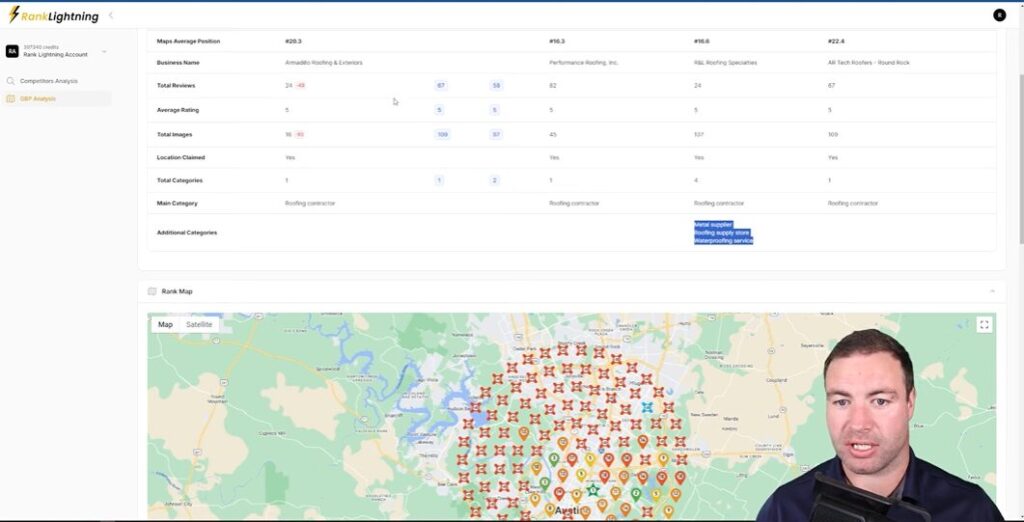
Have you ever lost a potential SEO client because you forgot to follow up? It’s a common scenario, and one I’ve experienced firsthand. To combat this, I devised a follow-up system based on consistency and personalization. I utilize reminders and software tools that keep me in touch with leads. This way, I never miss an opportunity.
Here's what my system looks like:
Nurturing leads isn't simply about sending them emails. It’s about building a relationship. When I nurture leads, I help them understand the value of my services. This connection often leads to long-term partnerships. After all, potential clients want to feel valued and understood, not just targeted for sales.
In the beginning, I relied on mass emails. I thought this was the way to go. But guess what? It didn't work. My approach in looking for SEO clients evolved as I realized that targeted, personalized messages yield far better results. Now, I focus on quality over quantity. I invest time in researching my leads to tailor my communications. This change has vastly improved my client engagement and conversion rates.
Quarterly reviews are a game-changer. They remind SEO clients of their progress and the goals we set together. I often ask them questions like, “What challenges have you faced since our last discussion?” This opens the door for valuable dialogue. I find this as an opportunity for me to reposition my services as solutions for their evolving needs.
Keeping SEO clients engaged is not a one-time effort. I’ve adopted several strategies, such as:
By providing consistent value, I show clients that I am invested in their success.
Let me share a quick story. I once worked with a roofing company that was skeptical about investing in roofing business SEO. Through a well-crafted follow-up system, I reconnected with them after their initial inquiry. After several months, they saw their website traffic improve drastically, leading to new business. I followed up regularly, keeping the lines of communication open. This success story highlights how nurturing relationships can lead to fruitful outcomes.
In summary, fostering relationships isn't just about making the sale. It’s about creating lasting connections. When you implement thoughtful follow-up strategies, nurture your leads, adapt your approach, and remain engaged, you will find the right SEO clients and see tangible results over time.
Demonstrating your skills by offering basic and complimentary SEO services is a great way to establish credibility in the field as you start your digital marketing agency. By providing a demo of your basic services for free, you can attract potential SEO clients who may later be interested in more comprehensive solutions, creating opportunities for future business.
In addition to showcasing your expertise, free SEO services can be an effective marketing strategy. This approach allows you to build a portfolio that you can share with prospective clients, demonstrating the effectiveness of your techniques in every niche. This initial interaction can help build trust and rapport, making potential SEO clients more likely to consider your paid services after experiencing the benefits of your free offerings.
Moreover, offering basic SEO services at no cost can improve your visibility in a competitive market. The most basic SEO services you can offer is a simple site audit through Surfer Audit or a sample of a strategic keyword research appropriate for their site. As you help businesses enhance their online presence, you gain practical experience and generate word-of-mouth referrals. This can lead to greater recognition and a stronger reputation in the industry compared to other leading SEO agencies, ultimately positioning you as a trusted expert for SEO solutions. Offering services for free entices more SEO clients to consult you for their site improvements, encourages word of mouth recommendations, and thus makes you stand out as a startup digital marketing agency.
As I reflect on my journey handling my own digital marketing agency, I cannot stress enough how crucial authenticity is in our outreach efforts. When we communicate genuinely to every SEO client, we build trust. Trust leads to relationships, and relationships often turn into long-term clients. But how do we cultivate this authenticity?
First, let’s look at the idea of being real in your communication. It’s like having a conversation over coffee instead of a formal meeting. Think about it: people can find and sense insincerity a mile away. Whether through emails or face-to-face meetings, being yourself and showing your true intentions can set you apart from other SEO agencies.
In my more than 5 years of handling my own SEO agency, I believe honest communication is the backbone of successful relationships. When I started focusing on transparent and open dialogues with my clients, I noticed a significant difference. This is a very important factor on learning how to get SEO clients.
“Transparency breeds trust, and trust is essential for success.”
Are you really being candid? Or are you just telling them what they want to hear? Reflect on this.
Don't shy away from your mistakes. I’ve had my share of failures as I started my SEO agency way back, but each one taught me valuable lessons. If you see a setback as an opportunity to grow, you can harness its power. Success isn’t about never failing; it’s about learning and improving from failures.
Listening is just as, if not more, important than speaking. Understanding your client’s needs will guide your approach to create strategies for improving their site. Are you truly hearing their pain points, or are you too busy preparing your pitch? When SEO clients feel heard, they are more likely to trust you and feel valued.
Consistency is about aligning your actions with your values. Here are a few tips to remain consistent as you look for SEO clients:
I believe in working smart rather than burning the midnight oil. Efficiently leveraging your time will yield better results. Use SEO tools that automate but don’t lose that personal touch. Just like how I utilize Rank Lightning, Semrush, and Open AI to streamline workflows and maximize performance while ensuring I provide personalized insights to clients.
In conclusion, being genuine and helpful is not just a strategy; it’s a philosophy. If we can embrace honesty in all aspects of our outreach and connect authentically with our clients, we pave the way for enduring relationships. Remember, the road may be rocky at times, but each experience molds us and brings us closer to success. Be consistent, stay true to yourself, and always strive to be better, smarter, and more helpful. That’s the ultimate takeaway. Let’s grow together and find the best SEO service suited for your needs.
Have you ever felt lost in the vast sea of keyword data? Trust me, I've been there. When I first discovered Google Search Console, it felt like unlocking a treasure chest filled with valuable insights. As someone who understand the importance of SEO, I learned to tap into this powerful tool to not only identify the keywords driving traffic to my site but to strategically craft content that speaks to my audience. Join me as I share my journey and tips on how to use Google Search Console for keyword research.
TL;DR: Google Search Console is an indispensable tool for keyword research, helping you identify valuable keywords, analyze performance, and develop content strategies to enhance your site's visibility. In this guide, we explore its functionalities and how to leverage them effectively.
When I first started diving into SEO, I quickly realized that keyword research is the key to rank on the first page of Google and drive traffic to your site. One of the best tools I found for this is Google Search Console. Have you used it yet? If not, let me share why it’s essential for your keyword research.
Google Search Console provides accurate keyword performance data. This means you can look at how well your chosen keywords are performing over time. For instance, when I analyzed my metrics, I saw which keywords resulted in clicks versus those that didn’t receive much attention. This data helps to paint a clear picture of what works and what doesn’t. Think of it like being a detective - tracking down the clues that lead to traffic!
Another advantage is the ability to track impressions and clicks. You can see how many times your keywords show up in search results (impressions) and how many people actually clicked on them. I was amazed to find some keywords, like “Rank Lightning,” garnered 137 clicks with 186 impressions and a high click-through rate of 73%. This tracking is invaluable. Are you keeping an eye on your click-through rates?
Google Search Console excels in helping to identify relevant keywords for your audience. If I find people are searching for specific phrases, I can tailor my content to meet their needs. For example, I noticed interest in “SEO rank tool” recently. I plan to create focused content around that term to engage my audience better. Asking yourself, “What does my audience want?” can lead to valuable insights.
Lastly, this tool is truly essential for informed content strategy decisions. With keyword data in hand, we can craft our content to be more effective. It’s not just about writing; it’s about writing what resonates. For instance, if I see rising searches for “local rank checker,” it signals to me where I should focus my writing efforts.
In summary, using Google Search Console isn’t just about digging through numbers - it's about gaining insights that can steer your content strategy forward. Are you ready to leverage this powerful tool? It’s time to make informed decisions and elevate your SEO game.
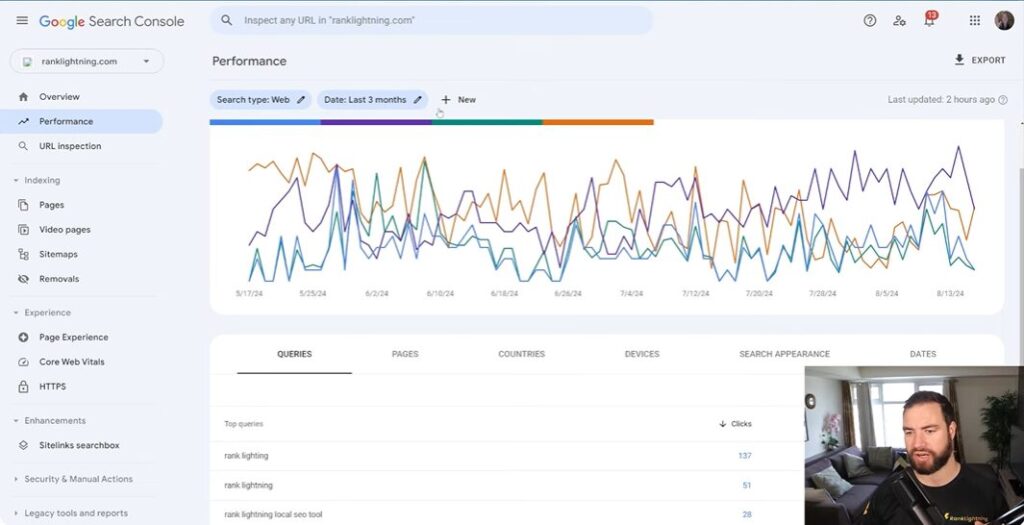
To begin, let’s figure out how to access Google Search Console. First, you'll want to visit the Google Search Console website. If you have a Google account, you’re halfway there! Simply log in with your credentials. Next, you need to add your website to the console by clicking on the "Add a Property" button. Make sure to verify your ownership - this can be tricky! But, genuine ownership is essential. This is only the first step in learning how to use Google Search Console for keyword research.
Once your account is set up, you can dive into the data. It's pretty neat how you can export keyword data to Google Sheets. After navigating to the "Performance" tab, select the date range that you'd like to analyze. This range should ideally cover at least six months to give you meaningful insights. I suggest clicking on the "Export" button, where you can choose to export to Google Sheets. This aids in better tracking and analysis - even I do a little happy dance when I see all that data organized!
Now comes the fun part - analyzing impressions and click data! In your spreadsheet, you’ll notice metrics like impressions, clicks, and click-through rates (CTR). For example, if you see a keyword with 200 impressions but only 5 clicks, that’s a red flag. Can you ask yourself, 'Why aren’t people clicking?' Consider optimizing your title tags or descriptions. Remember, the goal is to turn those impressions into clicks.
Lastly, it’s important to filter your data smartly. You can filter by device, date, or even search type. Why would you want to do this? Well, it can help you understand where your traffic comes from. For instance, if most clicks are from mobile devices, it’s crucial to ensure your site is mobile-friendly. I often toggle between filters to spot trends and patterns - this hands-on approach keeps the data relevant.
With these steps, you are now equipped to tackle Google Search Console effectively. Looking forward to seeing how you utilize these insights!
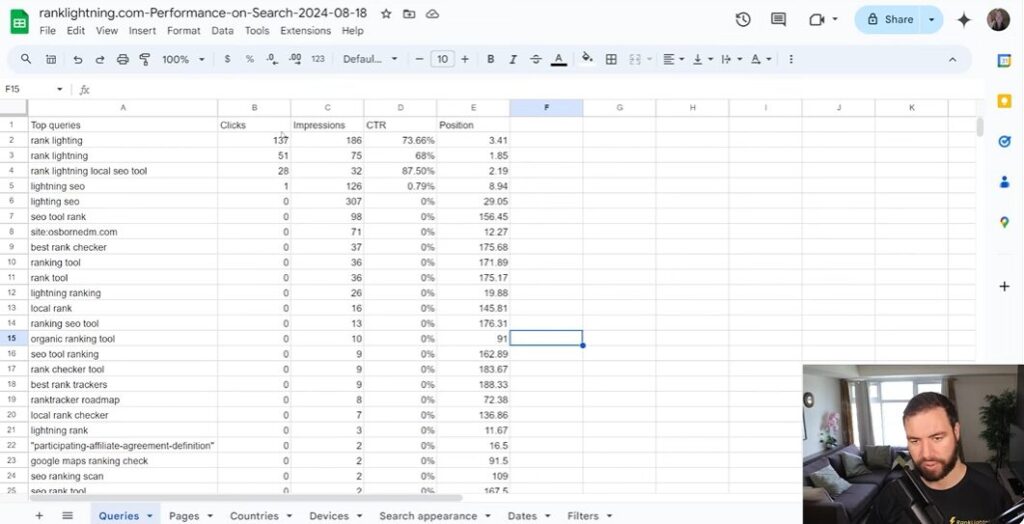
When we dive into the world of SEO, we quickly encounter the term impressions. But what does it really mean? Simply put, impressions indicate how many times a specific keyword appeared in search results. This metric serves as a sign of authority. The more impressions a keyword has, the more Google views it as relevant. This is a good starting point for evaluating which keywords could be worthwhile to focus on.
Think of impressions as the digital handshake between your website and potential visitors. Each impression is like an invitation to explore further. If you’re getting a lot of impressions for a keyword, it suggests that your site is visible in search results. But what next? You should consider how many of those impressions lead to clicks.
Impressions can be a key metric for selecting keywords. For instance, let’s say I’m analyzing keywords for a website about tree services. I notice that the phrase "tree removal" garners a decent amount of impressions. This tells me that people are searching for this term. If I can write quality content around it, I might capture their attention. Here’s a simple method to start:
It’s crucial to recognize the relationship between impressions and clicks. A high number of impressions without corresponding clicks might indicate that the snippet isn’t appealing. This situation often leads to questions like, "What can I change to entice users?" Updating the meta description or title tag can help increase that click-through rate.
Let’s look at some compelling examples. The keyword "Rank Lightning" on my site had 186 impressions and 137 clicks, leading to an impressive click-through rate of 73%. This is a prime example of how targeted keywords can drive engagement and traffic.
By using impressions effectively, we can shape our content strategy. It’s about aligning our focus on keywords that not only attract attention but engage users as well.
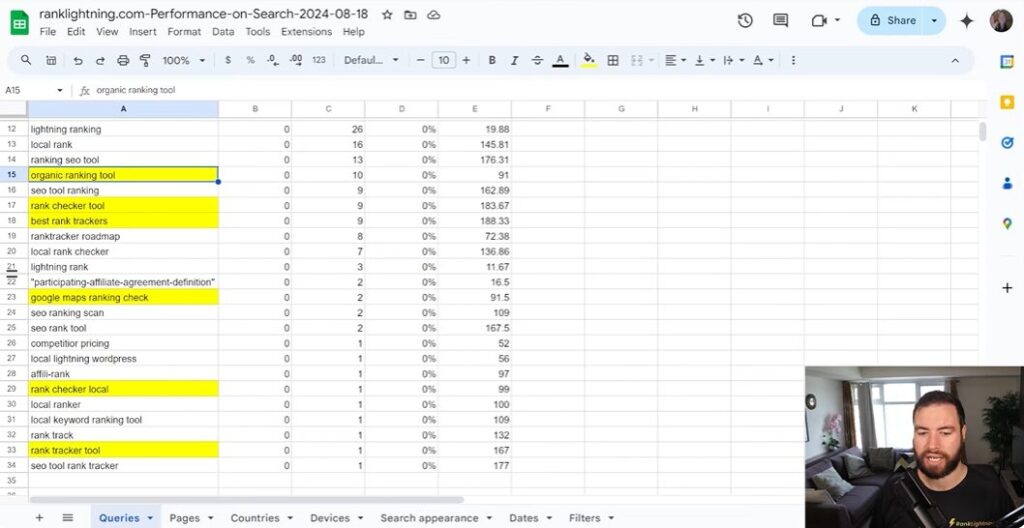
When diving into SEO, it's tempting to solely rely on tools like Google Search Console (GSC) for insights. But is that a wise choice? Let’s explore some of the potential pitfalls.
Google Search Console is a fantastic resource. It provides metrics that are incredibly useful, like impressions, clicks, and average positions of keywords. However, if we take these numbers at face value, we might fall into misinterpretation traps.
We should regularly check these metrics but always remember their limitations. Is it wise to put our faith solely in these numbers without questioning their context?
Keyword duplication is another valid concern. If I create multiple pages around the same topic or keywords, I risk diluting my SEO efforts. Why? Because Google might struggle to determine which page is the most relevant.
Before crafting content, validating search volume is crucial. There’s no point in spending time on a keyword that no one searches for, right? Using third-party tools can provide better insights into keyword viability.
Some key questions to ask ourselves include:
I’ve made my share of misinterpretations in the past. Here are a few examples:
Being aware of these pitfalls can significantly improve our approach to data interpretation. So, let’s be cautious and strategy-driven!
As we wrap up, I want to emphasize the importance of valid data for success. Without reliable information, we’re essentially sailing a ship without a compass. It’s your data that directs your course and helps you navigate the vast ocean of digital content.
I encourage you to regularly check and analyze keyword performance. Think of it as routine maintenance for your vehicle. Just like car engines need tune-ups, your SEO strategies need constant tweaks and evaluations. Setting a schedule - perhaps monthly or quarterly - allows for a comprehensive understanding of how your keywords are performing.
So, how can we create content based on keyword insights? It’s simple: start with the keywords that are already attracting traffic. For instance, if you discover that a term like “rank checker tool” is garnering attention, create engaging blog posts or resources around that topic. This approach not only gives users what they want but helps you gain authority in your niche.
Lastly, let’s talk about Google Search Console as an empowering tool. It’s like having a personal coach guiding you through every twist and turn in your content strategy journey. This platform provides valuable insights into how Google views your site, what keywords are driving traffic, and areas that may need improvement. Leverage this tool to refine your approach and make well-informed decisions. It’s your ally in a competitive digital landscape.
In summary, I hope you feel equipped to craft your content strategy with confidence. Learning how to use Google Search Console for keyword research is a big help. By recognizing the importance of valid data, continuously analyzing your keyword performance, and strategically creating content that aligns with insights, success is within reach. Embrace the data, ask yourself the hard questions, and keep Google Search Console close. Your journey toward a more powerful content strategy starts here.
As someone deeply immersed in the intricacies of digital marketing, I can’t help but marvel at the wild world of SEO. A few months back, I came across a curious case involving a roofing company in New Jersey that shot to the top of search engine rankings almost overnight. Immediately, I knew I had to investigate how they pulled off this impressive feat. Spoiler alert: it’s not what you might think! This article talks about an SEO case study on how to rank fast.
TL;DR: Discover the fascinating journey of a New Jersey roofing company that achieved rapid keyword ranking through strategic SEO tactics. This case study provides vital insights for anyone looking to enhance their search visibility.
Let’s dive into an intriguing case study about Roof Leak Repair New Jersey LLC. You might not have heard of them before, but their rise in the SEO world is nothing short of surprising. They have quickly climbed to the top of the search engine rankings for the highly competitive keyword, "roof leak repair NJ".
What’s their secret? It starts with a focused strategy. They built their entire online presence around this one keyword. You might wonder, is it really possible to become that successful by targeting just one keyword? The answer appears to be a resounding yes, at least for now.
Currently, when you search for "roof leak repair NJ", Roof Leak Repair New Jersey LLC is sitting pretty in the top spot. Using tools like Semrush, we can see how their visibility spiked. Yet, there’s an elephant in the room; their website's aesthetics aren't exactly award-winning.
But, who says looks matter when you can rank high? They optimized their homepage effectively for their target keyword, and that’s what counts!
Now, let's talk about the importance of keyword selection. It’s a foundational aspect of SEO that many overlook. In the case of Roof Leak Repair New Jersey LLC, they made a crucial choice by zeroing in on a specific keyword rather than trying to rank for multiple terms.
With a well-chosen keyword, you can design your content to serve the right audience and meet their needs. The question remains, are you focusing your SEO efforts effectively?
When we compare them to their competitors, it’s clear they have carved a niche for themselves. Other companies may have wider keyword targets, but they often struggle to achieve the same level of visibility. This gap represents an opportunity, especially for a business that can sense a demand in a crowded market.
In conclusion, keyword selection plays a pivotal role in achieving quick SEO results. While Roof Leak Repair New Jersey LLC showcases what can be done with a focused approach, it raises the question: could you replicate this success? What's your strategy going to be?
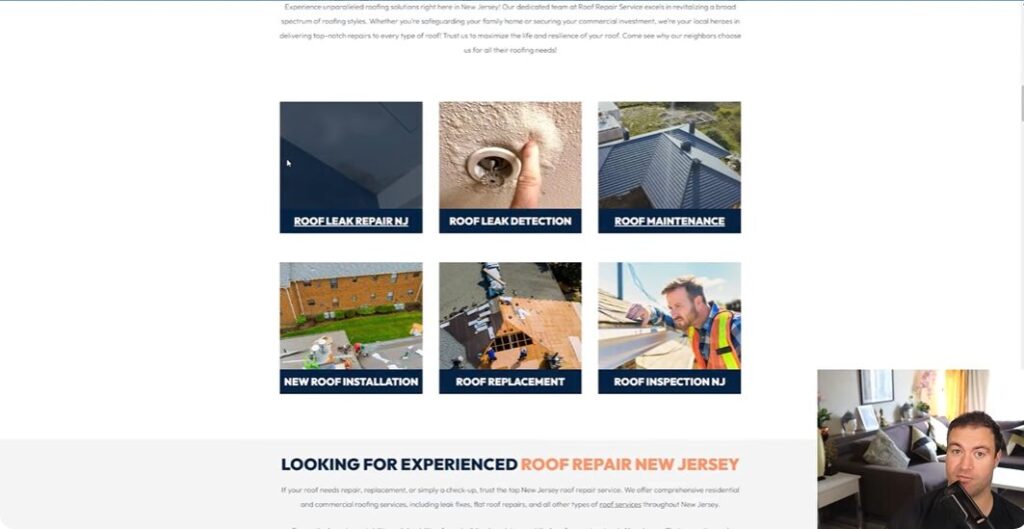
Have you ever clicked on a website and immediately felt uncomfortable? Maybe the colors clashed, or the layout was confusing. It's not just you. The appearance and structure of a website can make or break first impressions.
When I think about website design, I consider it like inviting someone into your home. If the entrance is cluttered and messy, would your guests feel welcome? Probably not. Similarly, a website that is visually appealing and easy to navigate says a lot about your professionalism and reliability.
According to Ron from Osborne Digital Marketing, a well-structured website is crucial for effective SEO. He emphasized the importance of creating a website that supports keyword strategies, as seen in his case study with Roof Leak Repair New Jersey LLC. This business not only chose a specific keyword to target but also structured its entire website around it. This laser focus led to rapid visibility in search rankings.
Have you ever thought about internally linking pages on your site? These links guide users and increase engagement. Ron discussed how Roof Leak Repair New Jersey LLC used exact-match anchor text to direct visitors back to the homepage. This not only helped with user experience but also bolstered their SEO efforts. The lesson here? Good structure enhances user journey.
Your website should reflect trustworthiness. A sleek design fosters credibility. If your website design looks outdated or unprofessional, why would anyone trust you with their business? As Ron pointed out, having robust social profiles that match your website also plays a crucial role in establishing your legitimacy with Google’s algorithms.
As you can see, the importance of a website’s appearance and structure cannot be understated. The right design not only attracts visitors but also helps your SEO strategies, giving you a better chance of ranking in search results. Are you ready to transform your website into a friendly space that welcomes visitors and retains their interest?
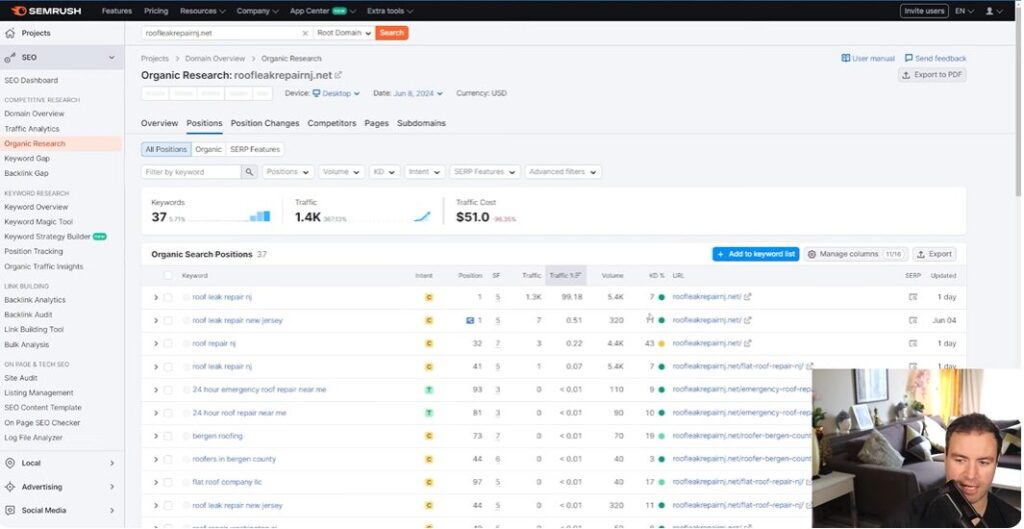
When we talk about a keyword-centric strategy for your website, we refer to the practice of centering your entire online presence around one specific keyword. This approach can seem simple, yet it carries both potential rewards and significant risks. For instance, imagine trying to rank for "roof leak repair NJ." By focusing entirely on this phrase, a business can quickly achieve visibility. But is that sustainable? The answer often varies.
Let's take a closer look at Roof Leak Repair New Jersey LLC. They structured their website around their targeted keyword. Everything from the homepage content to internal linking was optimized for "roof leak repair NJ." This laser-like focus made it effective in achieving that coveted top ranking in search results. However, I can't help but wonder about the long-term implications of this singular focus.
Now, here’s where things get interesting. While this business ranks well, their website's aesthetics left much to be desired. At times, a well-designed website can lure visitors in. Aesthetic appeal might enhance user experience, but if it's not functional, can it effectively serve its purpose?
The balance between looks and performance is tricky. I prefer a site that gracefully combines the both. Shouldn't we strive for both aesthetic appeal and functionality?
If I were in their shoes, I would advise diversifying a bit. Sure, focus on that primary keyword, but why not explore related terms? This could help capture a larger audience. Plus, I’d enhance the website’s design without diminishing its functionality. Why make a choice between aesthetics and usability when you can have both?
Moreover, I'd solely depend on ethical practices. The risks associated with click-through rate manipulation are alarming. Maintaining a credible online reputation greatly benefits long-term success.
In conclusion, a keyword-centric strategy can certainly yield quick results. However, I firmly believe a more balanced approach might lead to even greater success over time.
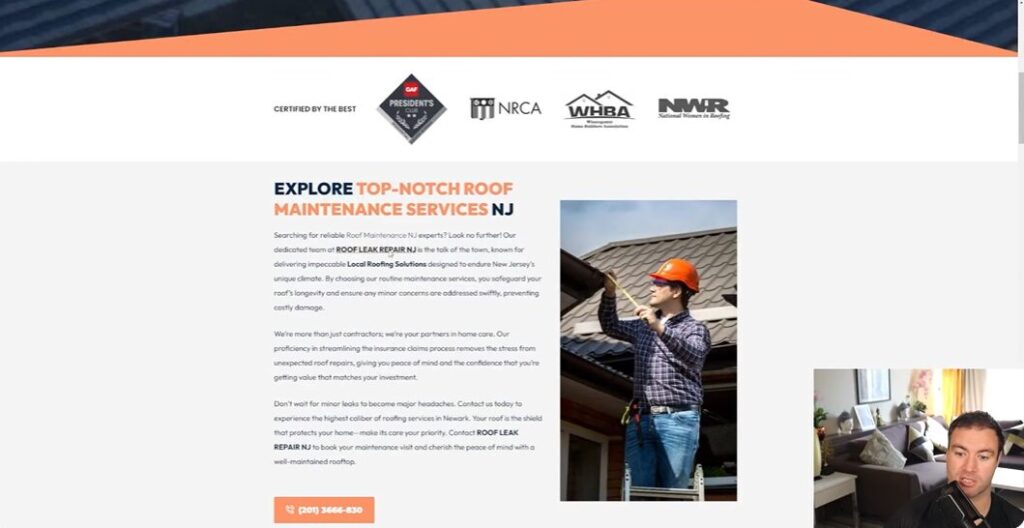
Internal linking is like the backbone of your website's SEO. But how does it actually help boost your performance? Let's dig into the SEO case study details on how to rank fast.
Imagine your website as a city. Each page is a building. Internal links act as the roads connecting these buildings. The more pathways you have, the easier it is for visitors - and Google - to navigate. It’s true! When you use internal links, you guide search engines to understand your content better. When they see links directing back to your homepage or important service pages, those pages earn a bit more authority.
One key strategy is creating exact-match anchor text. This makes sure the phrase you’re hyperlinking closely matches the content on the target page. For example, if you link “roof leak repair NJ” to the homepage of a roofing business, it strengthens their visibility for that keyword.
Local SEO is crucial for businesses like Roof Leak Repair New Jersey LLC. Why? Because it allows them to target customers in their specific area. Tactics include:
When you incorporate these strategies, you effectively place your business on the map - literally and figuratively. I mean, who doesn't search “best pizza near me” these days? You want to be the one they find!
Building backlinks is essential, but they have to be credible. Here are some tips:
Remember, links from shady sites can hurt you. It's a fine balance. Just like in relationships - quality connections matter!
From Ron's case study, it’s evident that while rapid results can be enticing, they come with risks. For example, manipulating click-through rates (CTR) can seem like a quick fix. But in reality, it might backfire if Google changes its game. Ron cautions about relying too heavily on this tactic. Short-term gains could lead to long-term pain.
Additionally, it's important to remember that inflated reported metrics might not reflect true user interests. If you aim for quick visibility without sound practices, you risk your website's credibility.
So, let’s keep our eyes open and navigate these waters carefully. Effective internal linking and local SEO are powerful tools, but understanding the bigger picture ensures sustainable growth for our online presence.

Click-through rate (CTR) manipulation refers to the practice of artificially inflating the number of clicks on a website. Simple, right? But it matters a lot. Why? Because it creates a misleading picture of a site’s popularity or demand.
Let’s say you own a roofing company. You might start using tactics to draw more clicks to your site than you normally would get. Suddenly, your site seems like the hottest topic in town! But in reality, it’s just a mirage.
Many businesses jump into CTR manipulation as a quick way to climb search engine rankings. They might use clickbots, misleading titles, or spammy ads to drive traffic. In the short term, this might seem effective. But what happens when search engines catch on?
Even Ron from Osborne Digital Marketing cautions against these tactics. He emphasizes that while some companies can achieve fast results, they are often not sustainable. Google updates its algorithms all the time. So, what worked yesterday might backfire tomorrow - leaving you with a sinking ship.
There's a fine line between clever marketing strategies and spammy practices. Think of it like walking a tightrope. One slip can lead to a fall!
When we walk that tightrope, we might think we’re just being smart. But we have to ask ourselves: Is it worth the risk?
Tracking traffic accurately is crucial. The discrepancies Ron pointed out surrounding search volume metrics illustrate this perfectly. If we’re using skewed data, how can we trust our analytics? It’s like using a funhouse mirror; you’re not getting an accurate reflection.
By analyzing the real data, we can uncover valuable insights. This is where we learn what works and what doesn’t. So, what can we conclude from all this? Staying honest with our analytics will lead to long-term success. That’s something we can bank on.
As we wrap up our discussion on the SEO case study presented by Ron from Osborne Digital Marketing, let’s take a moment to reflect on the key insights gleaned from his experiences on how to rank fast. It's fascinating to see how a business like Roof Leak Repair New Jersey LLC achieved significant ranking success with a laser-focused approach.
Ron highlighted that a targeted strategy is central to achieving quick search engine visibility. By concentrating on a single keyword - “roof leak repair NJ” - this company structured its website around this focus. It underscores the need to effectively optimize homepage content and use precise internal linking strategies.
As compelling as these tactics are, it’s important to remember ethical practices in SEO. Manipulating click-through rates or engaging in deceptive strategies might offer a temporary boost but can threaten long-term success. As Ron pointed out, the sustainability of these rankings is questionable. Shouldn’t we strive for authenticity instead? After all, trustworthiness can lead to stronger, more meaningful connections with our audience.
For small business owners, my advice is simple: build a credible website and focus on genuine content. A strong online presence is vital. Ensure your website is structured for success with proper internal and external links. This will help your business gain not just visibility but also trust. Ask yourself, what kind of value are you providing to your visitors?
I’ve seen firsthand the allure of quick ranking tactics, and I can empathize with the temptation to chase immediate results. However, I often find myself wondering: at what cost? Fast results often come with risks, and as Ron emphasized, the volatility of strategies aimed solely at rapid ranking can leave businesses vulnerable to the ever-changing landscape of search algorithms.
In conclusion, while speed can be appealing in the world of SEO, I believe that combining quick tactics with foundational ethical practices creates a more stable path forward. Let’s embrace strategies that not only bring us to the top quickly but also sustain our rankings over time by adding true value for users. As we continue our SEO journeys, let’s aim for integrity and authenticity in everything we do.
As a digital marketing enthusiast, I often find myself lost in the maze of search engine optimization. Just the other day, while brainstorming for a client’s bathroom remodeling page, I stumbled upon the pivotal role of LSI keywords. It hit me - a simple element that can transform the effectiveness of content is often overlooked! Join me in uncovering how to find LSI keywords - let's make our content shine and have your business achieve first-page rank in the eyes of Google!
TL;DR: Discover the importance of LSI keywords and learn practical methods to uncover them for your digital marketing strategy to enhance SEO performance.
Latent Semantic Indexing (LSI) keywords are those words or phrases that closely relate to a primary topic. Here's a quick example: imagine you're writing about bathroom remodeling. LSI keywords would include terms like tiles, vanities, and waterproofing. They add depth and context to your content, allowing search engines like Google to better understand what your page is about.
Why should we care about LSI keywords? Well, think of it this way: Google is always improving its ability to understand what content really means. If your page lacks these semantically related terms, it could send the wrong signals to search engines.
In essence, incorporating LSI keywords is a way of showing Google that your content is relevant and comprehensive.
Let’s break it down with a few niche examples:
These LSI keywords help create content that's not just focused but also informative and engaging. They add a layer of relevance that should draw the reader in.
Now, what’s the difference between primary keywords and LSI keywords? To put it simply:
Using both effectively creates a well-rounded piece of content. When you sprinkle latent semantic indexing (LSI) keywords throughout your text, you make it easier for a search engine to notice connections. This is essential in driving organic traffic.
I hope this clarifies what LSI keywords are and their significance in SEO. It’s a fascinating aspect of digital marketing that can really enhance your content!

I want to dive into a topic that's vital for anyone looking for the best SEO practices - LSI keywords. But first, let’s simplify things a bit. What are LSI keywords? They are words and phrases that are semantically related to your main topic. For example, if we focus on "garden design," some relevant LSI keywords might be "landscaping," "flower beds," and "outdoor furniture."
So, why are these keywords crucial for SEO? Think of LSI keywords as the seasoning in your dish. They add flavor and depth, making your content more attractive to both search engines and readers. Google, nowadays, is smart. It’s not just about stringing one word with another; it’s about context. If your content is void of these related terms, odds are, it’s likely missing the mark.
Learning how to find LSI keywords isn't as daunting as it may seem. Here are a few ways I often use:
Let’s face it: LSI keywords are your buddies in the SEO landscape. They make your content richer and way more appealing. If you’re not using them already, you should start incorporating them into your articles. After all, wouldn’t you want your work to shine on search engines after months of strategizing? Let’s get to work!
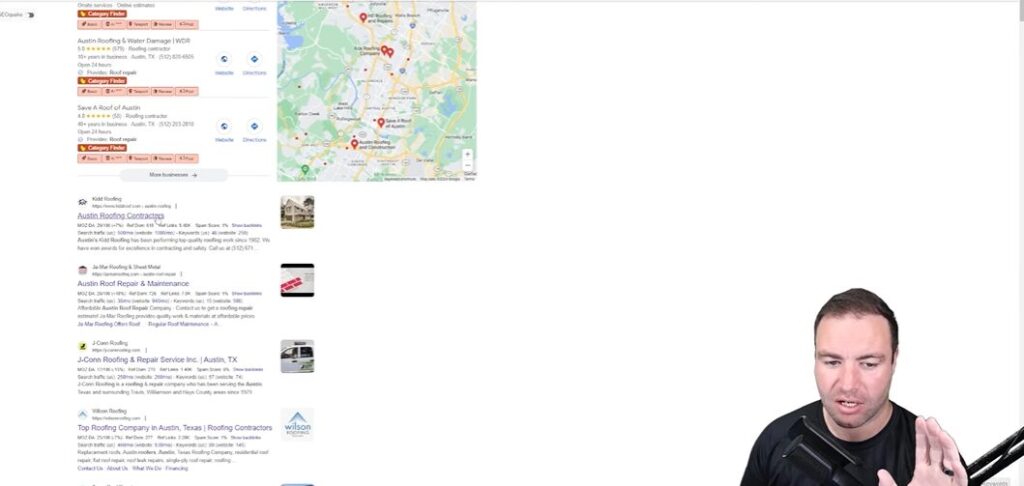
When I think about finding the right keywords, I often visualize. It’s an effective technique to discover what resonates with both businesses and customers. But how does this work? Let’s explore!
The first step in utilizing imagery is visualization. Picture yourself in a specific context. For instance, if you're focusing on "outdoor furniture," what images come to mind? Decks, sun loungers, barbecues? By visualizing these elements, I can start forming a list of keywords that relate directly to my target topic. This technique is not just creative; it’s a strategic way to determine the best keyword for your content or website.
Our brains naturally associate images with words. Think about it: when I see a cozy living room, I immediately think of furniture, decor, and warmth. These associations become keywords, allowing us to craft content that resonates with what people are searching for. Have you ever noticed that your mind creates a story based on visuals? That’s the kind of link we want to create with keywords.
Each industry creates unique visions that lead to specific keywords. It’s all about painting the right picture!
So, how do we bridge this gap? Once you have a list of keywords generated from your imagery, it’s time to refine and expand upon them. I often compile my imagery-based keywords into a spreadsheet. This way, I can categorize and analyze them. Think of it as creating a bridge from your imagination to your marketing strategy. Are all your visualized keywords included? Are you missing any key phrases?
Incorporating imagery can revolutionize your keyword discovery process. Try it out - visualize a topic and see where it takes you! Your next big optimization may just be a mental image away.
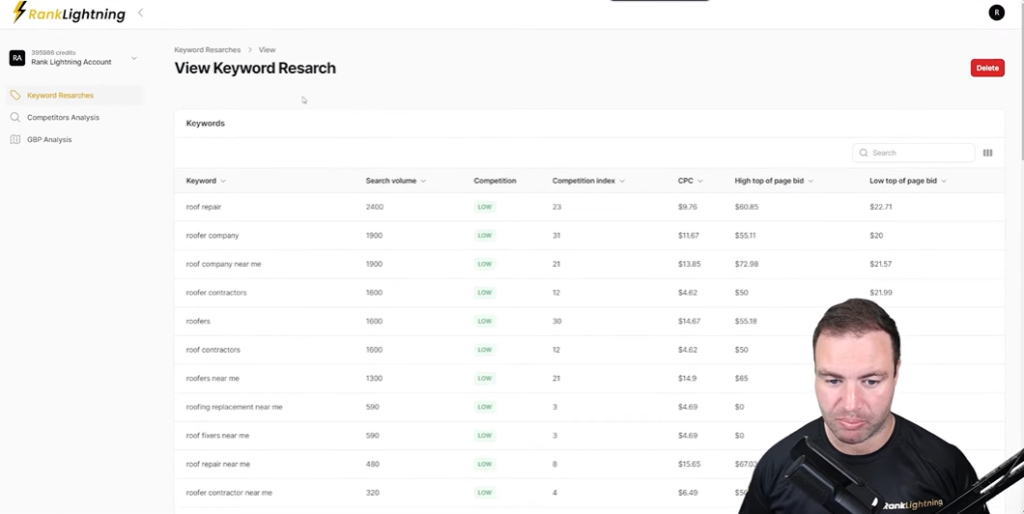
Let’s face it: finding LSI keywords can be a pain. But that’s where Rank Lightning comes in. It’s an SEO tool designed to simplify the keyword research process. Think of it as your digital flashlight in the dark world of keywords. You input your main keywords, and it lights the way to a cornucopia of related terms. I can’t stress enough how valuable this tool is as you prepare for its upcoming launch.
For those on the early sign-up list, there's an exciting discount coming your way! This is more than just a tool; it’s an investment in your online success. Trust me, being an early adopter will pay off.
So, how do we get started? Here’s a quick step-by-step guide:
It’s that simple! Soon, you'll find your content improve and ranking higher.
Google is a fantastic yet free tool for keyword research. Just type your primary keyword into the search bar and review the results. I recommend choosing the top-ranking page. Why? Because Google ranks these pages for a reason - they are seen as relevant and authoritative. Using the SEO Quake browser extension can help identify the keyword density on that page.
By checking out the keyword and phrases that are frequently mentioned, I gather insights that let me know what Google values. This method is straightforward yet very effective.
Now, you might wonder, why not just rely on tools? There’s value in manual methods as well. I often combine both approaches. AI tools like ChatGPT can generate lists of LSI keywords quickly. However, I prefer doing it manually when I can. It helps me understand the nuanced language around my topic.
Each method complements the other. Tools provide efficiency; manual exploration offers depth. In the end, the mix leads to powerful LSI keyword strategies that elevate your SEO game.
With the right techniques and tools like Rank Lightning, you're well on your way to becoming a keyword wizard. It takes a bit of effort, but the results? They’ll be worth it!
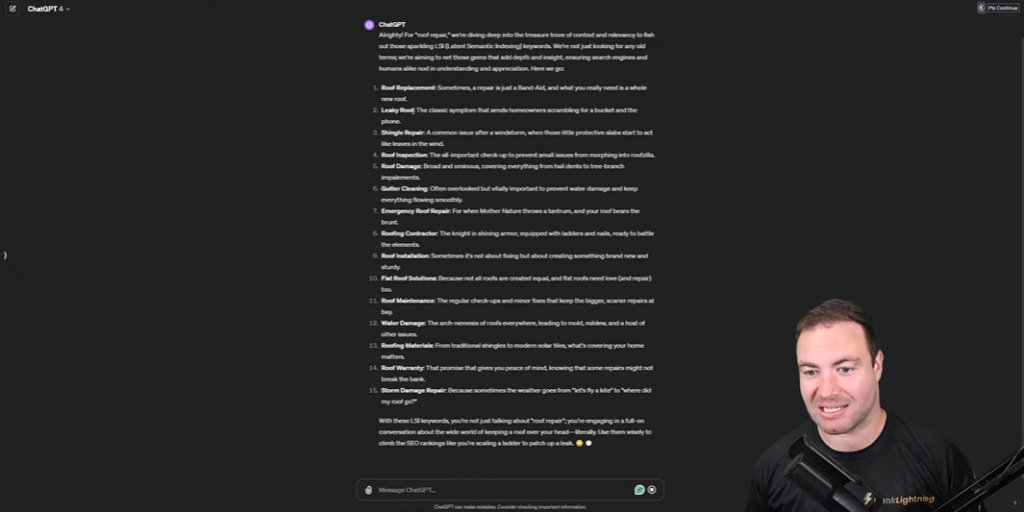
When looking through into SEO, we often hear about keywords, backlink building, and strategies. But there’s one vital aspect that shouldn’t be overlooked: contextual relevance. Why does Google value contextually relevant contents? Well, let’s explore this and see how it affects our SEO efforts.
Google has evolved significantly; it’s no longer just about matching keywords. Google aims to deliver the most relevant results to user queries. This means that if your content lacks context, Google may not recognize its relevance. Think about this: if you write about “bathroom remodeling” but don’t include related terms like tiles or sinks, you're missing the bigger picture. In this digital age, context is king!
Let’s talk LSI keywords. These are phrases or words related to your primary topic. For instance, if your focus is on “home renovation,” words like “interior design,” “contractors,” and “paint color” could all be LSI keywords. The real-world implications of using them are numerous:
Imagine this: You implement LSI keywords effectively and your website traffic increases. More visitors mean more eyes on your content. But wait! This isn't just about traffic and topping search results. It’s about converting those visitors into leads, revenue, or sales. This is the domino effect of SEO. Higher search traffic can lead to higher conversions, if the right keywords and context are in place. I’ve seen it happen many times!
So, how do we implement LSI keywords effectively? Here are some methods that I’ve found useful:
By following these best practices, I assure you will see significant improvements in your SEO efforts and you will surely rank higher in search results. Unlike PPC and paid ads, these SEO strategies may take longer but the results are worth it.
In the world of SEO, every keyword and context is a critical element that can't be ignored. It's about understanding the relationships between words and how they create relevance. Let’s remember that Google is looking for context to help users find the best content. This is not just a strategy; it’s a necessity in today’s digital landscape.
As we wrap up this journey into the world of SEO, let’s take a moment to reflect on the significance of learning how to find LSI keywords and combining it with your website's silo structure to form a good strategy. I can't stress enough how vital they are for creating well-optimized content and be on the first page of search results. If you think about it, these keywords form the backbone of search relevance. They help search engines better understand your website's context. When you weave in LSI keywords related to your main topic, like “bathroom remodeling” along with terms such as “tiles” or “vanities,” you create rich, engaging content or page. It's like painting a detailed picture rather than leaving it as a simple outline. Wouldn’t you want your audience to get the full image?
Now, let’s talk about engaging with the right tools for keyword discovery. Tools like Rank Lightning can be game-changers. There are also free tools available such as Google Search. By simply entering your primary keywords, you can uncover a treasure trove of related terms. And trust me, the more keywords you gather, the better your chances of attracting traffic. When was the last time you thought outside the box to discover new ideas? It’s time to explore!
After you've integrated LSI keywords into your content, how do you check if your efforts paid off? It’s simple. You'll want to monitor your keyword rankings and traffic with tools like Google Analytics. Keep an eye on how your content performs based on the keywords. I often use a simple checklist: Are my rankings improving? Am I getting more clicks? Am I seeing increased engagement? These factors are your signposts on the road to success.
In closing, remember that SEO isn’t just a one-off project; it’s a continuous effort. Stay updated with the latest trends and best practices, and don't shy away from experimenting. Organize your SEO planner to get optimal results. The landscape of SEO is dynamic, and adapting to changes is key. Incorporating LSI keywords can dramatically boost your visibility. So, as you embark on your SEO journey, think of these words: analyze, adapt, and apply. Your dedication to these practices will set you apart in the bustling digital marketplace and eventually make more money.
Remember, we are all in this together, sharing tips and strategies to thrive. I can’t wait to hear about your successes. Together, let’s continue learning and growing in the fascinating world of SEO!
As a digital marketer, I've often wished for an easy, free way to monitor my backlinks effectively. It wasn't until I stumbled upon a unique Google Sheets setup that I realized I could customize this tool to track my backlinks without breaking the bank. Today, I'm excited to share my journey and a step-by-step guide on how to use this free backlink monitoring tool with you all!
TL;DR: Learn how to track your backlinks using a completely free Google Sheets tool! Follow these simple steps to boost your SEO strategy without spending a dime.
Backlinks, or links from other websites to yours, play a critical role in SEO. They are like votes of confidence. Each backlink signals to search engines that your content is trustworthy. More importantly, higher-quality backlinks can significantly boost your site's visibility. It’s vital - no doubt about it!
In the digital marketing realm, backlinks are everything. Think of them this way: If others link to your content, it shows that you provide value. This can lead to higher rankings in search results. According to a study by Moz, “link signals” are among the top ranking factors.
Not all backlinks carry the same weight. A link from a trusted site holds more value than one from an unknown blog. These high-quality backlinks enhance your site’s authority, leading to better search engine rankings. It’s like having endorsements from industry leaders.
Ignoring backlink health can be detrimental. Broken or toxic links to your site can harm your SEO efforts. I once faced this challenge. I noticed a decline in traffic because I had neglected my backlinks. Once I focused on monitoring them, my traffic improved. That’s the power of maintaining backlink health!
In my experience, utilizing a simple tool reaped great results. I used a free backlink monitoring tool linked to a Google Sheet to track my backlinks. I was surprised at how easily I could manage my backlinks and identify potential issues.
Monitoring backlinks isn’t just a task; it’s a necessity for maintaining your website’s health in the competitive digital landscape.

You might wonder how a simple Google Sheet can become a powerful tool for monitoring backlinks. In my experience, it’s all about organization and clarity. The Google Sheets tool I’ve set up is designed to track essential backlink data like live status, link destination, and indexing status. It’s user-friendly and accessible, making it a great choice for anyone looking to stay on top of their backlink game.
Doesn’t that sound easy? This setup should hardly take five minutes of your time.
Once the sheet is ready, it's time to add your URLs. Choose the designated columns for your URLs. For instance, I often use an example from HARO linking to my site, Osborne Digital Marketing, just to showcase the functionality. It's as simple as pasting the URL into the right cell.
With this tool, you will save time and increase productivity. How valuable is that for managing your backlinks? I encourage you to explore its capabilities.
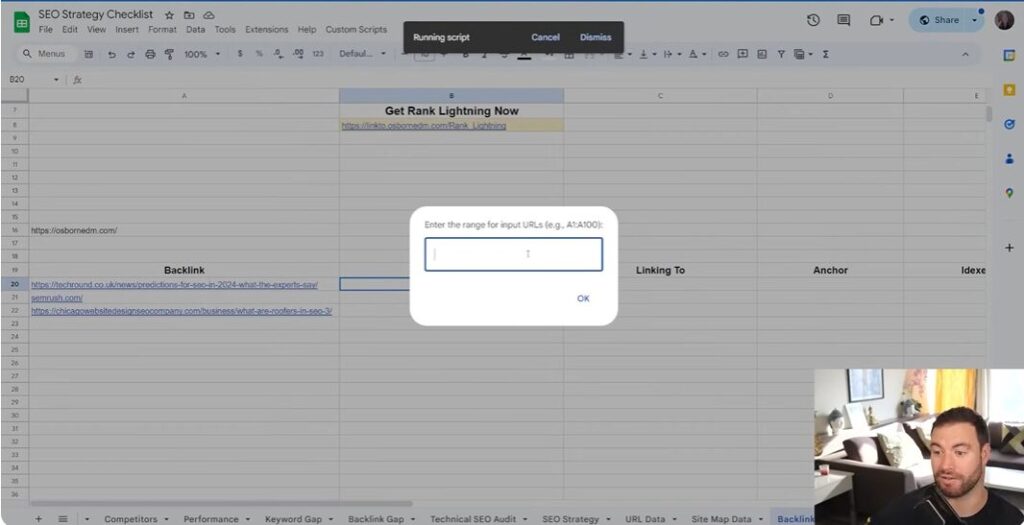
When it comes to SEO, one of the key elements to keep an eye on is backlinks. They're like votes of confidence for your website. But how do we track these essential links without spending a dime? I’m going to share some effective ways to track backlinks for free. Let’s dive in!
Using Google Sheets is one of the best ways to manage your backlinks. I created a free backlink monitoring tool that anyone can use. The first step is to open a new sheet. You want to set up some simple columns:
Once you’ve set that up, delete any pre-existing data and start inputting your URLs. For instance, I often use links from HARO that lead back to my site. This really helps in analyzing their performance.
Did you know you can automate some of your tracking? By heading over to the Extensions section in Google Sheets and selecting Macros, you can run a script that’ll analyze the backlinks. Don’t worry if this sounds complicated; running this script gathers all sorts of valuable information about your links. It tells you if they’re live, the linking URL, and even the indexing status. Pretty neat, huh?
Let’s make it even simpler. You can set up conditional formatting to automatically flag any links that go inactive. This way, if a link stops working, it’ll get highlighted right away. Keeping track of this will save you so much time!
Regularly checking your backlinks is crucial for your SEO strategy. It allows you to ensure your links are functioning properly, which can improve your website’s ranking. So, how often should you check? Setting custom triggers to run the script every two or four weeks can keep you on top of things.
Remember, while tools like my Rank Lightning tool are comprehensive, this free method absolutely deserves your attention. Plus, it’s super user-friendly. If you’re looking to save money while staying organized, this is the way to go.
So, don’t wait. Start tracking your backlinks today and take charge of your SEO journey!
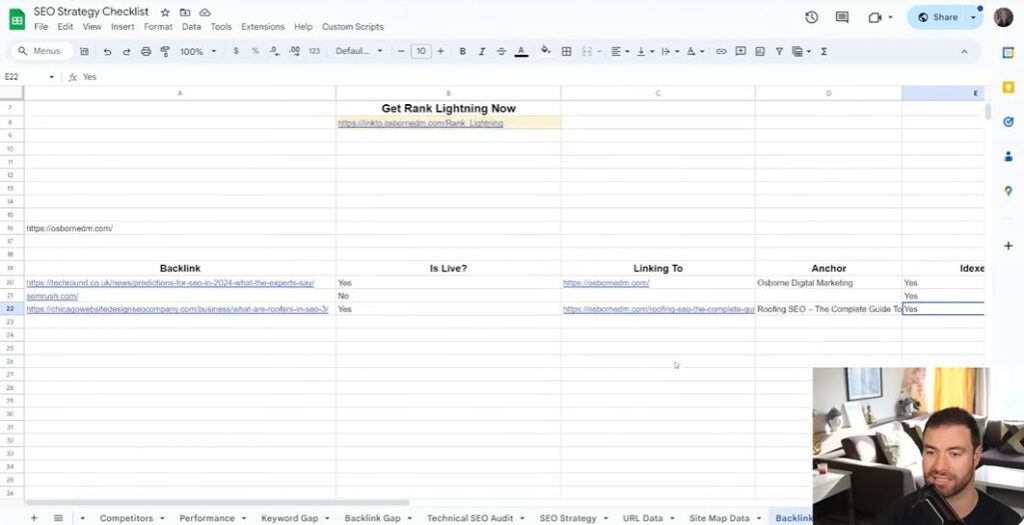
When it comes to analyzing backlink data, we really need to focus on several key elements. Let’s break them down together!
Your dashboard is your control center. It provides a wealth of information at a glance. But what do these metrics really mean?
Knowing these metrics helps us make informed decisions about our backlink strategy.
Have you ever found broken links on your site? It’s frustrating! Regularly checking whether links are live and indexed can save us a lot of trouble later. A handy way to track this is by using tools like Google Sheets. You can set it up to flag any links that aren’t working.
Anchor text deserves its own spotlight. Rhetorically speaking, would you click a link that says “click here”? Or one that describes the linked topic? Exactly. The words used in anchor text can provide context to both users and search engines. They influence how your site is perceived.
I recently analyzed a backlink from HARO that pointed to my site, Osborne Digital Marketing. I opened my Google Sheet, checked if the link was live, and reviewed the anchor text used. This hands-on approach allowed me to visualize my strategy in real-time. It was enlightening to see how each link was performing.
By following these steps, you too can effectively monitor and analyze your backlinks. It’s about making sure that each link is working hard for your site.

When it comes to monitoring backlinks, time is everything. That's why I believe in automating as much as possible. Setting up triggers in Google Sheets can change the way you track your backlinks.
First, I want to highlight how to set up triggers for your backlinks monitoring. This process can seem tricky, but it’s relatively simple. Here’s a step-by-step breakdown:
Extensions menu, select Apps Script.Triggers icon (clock icon).This could be the key to saving time!
What are the benefits of automating these checks, you ask? Well, think about it: less manual work means fewer chances of error. Automation can run background checks without interrupting your day-to-day tasks. It’s like having a second set of eyes on your backlinks, ensuring everything is ticking along smoothly.
Now that we’ve automated the checks, it’s essential to set a schedule for these data checks. Establish a routine. Weekly or bi-weekly checks create consistency in monitoring. By scheduling regular intervals, you can ensure that your links are still effective and active.
For example, let’s say you set your script to run every two weeks. On Monday mornings, I can sip my coffee while the script checks the status of my backlinks. By the time I’m done with my coffee, I’ll have a clear report: which links are alive, which need attention, and so forth.
Now that’s what I call a smart use of my time!
Incorporating automation into your backlink strategy is not just a method; it’s the modern way to keep your SEO game strong.

When we dive into the world of backlink tools, there’s a lot to consider. These tools can either make or break your SEO strategy. So, let's talk about their pros and cons. What should we be aware of?
In my exploration of these tools, I found that striking a balance between using the tool and applying personal insight is key. It’s about making informed decisions based on both data and instinct.
Have you experienced any of these advantages or disadvantages with your backlink tools? I’d love to hear your thoughts!
As we wrap up, let’s take a moment to reflect on the incredible benefits of the free backlink monitoring tool we've discussed. It’s not just about tracking links; it’s about ensuring that your SEO strategy is robust and effective. With this tool, you can easily identify live links, monitor their status, and even set automated checks to stay ahead of the game.
Implementing the strategies I've shared will not only streamline your backlink process but also enhance your overall SEO performance. If you’re new to backlink monitoring, start with the basics: paste your URLs, run the analysis, and keep a close eye on your metrics. Remember, consistency is key. Regular monitoring will help you catch inactive links early, allowing for timely adjustments.
I genuinely want to hear from you. How do you plan on using this monitoring tool? Have you faced challenges that you think this tool can resolve? Your experiences are valuable, and sharing them can benefit others in our community.
Please take a moment to comment below. I encourage engagement because it fosters learning for everyone involved. Let’s build a conversation around our experiences and best practices. After all, we’re all here to elevate our SEO strategies together. So, don’t hesitate to hit that comment button and share your insights! The path to mastering backlink monitoring is a shared journey, and I’m excited to see where it leads us.
Utilize this free tool to its fullest potential and watch your digital presence grow!
When I first dipped my toes into the world of SEO, I felt overwhelmed by the labyrinth of strategies, all promising the golden ticket to success. It was a casual afternoon, hunched over my laptop with a ton of tabs open—each a beacon of hope—that I stumbled upon the skyscraper technique. Do you know that feeling when a concept just clicks? Well, that’s exactly how it happened for me. This technique is not just about building backlinks; it’s an art of elevating content to heights that attract both readers and valuable links. Today, I want to share with you my journey and insights as we explore this technique together to get exceptional SEO services. Get ready to elevate your SEO game with this skyscraper backlink strategy guide!
TL;DR: Discover the skyscraper backlink strategy that helps you create better content, attract quality backlinks, and improve your website’s local SEO performance step-by-step.
The Skyscraper Backlink Strategy is a content marketing technique designed to improve SEO through effective link-building. As I explore this strategy, let’s break down its definition, purpose, underlying principles, and even look at a successful implementation that can help you grasp it better.
In simple terms, the skyscraper technique is about finding high-ranking content that has gained significant backlinks and then creating something even better. Picture this: if a competitor has a blog post titled, "How Much Does a Roof Replacement Cost in South Florida?" I would create a detailed guide that not only covers that topic but also adds value by including statistics and regional specifics.
The purpose is clear. We aim to outshine the existing content and earn backlinks by being the most comprehensive, updated, and engaging resource in the niche.
Backlink building is a cornerstone of SEO. It's about getting other websites to link to your content. But why do we need backlinks? Think of them like votes of confidence. The more quality links pointing to your content, the more credible and valuable it appears in the eyes of search engines - it’s all about demonstrating authority
Let’s go through an example. Imagine I find an article that has dozens of backlinks, yet it lacks local insights on roof replacement costs. I’d write a piece that includes detailed county data and the latest trends in roofing. This sets the stage for building backlinks by offering something fresh and more valuable.
From there, outreach is crucial. I would contact webmasters who link to the original article, showing them how my resource enhances their readers' experience. Instead of just asking for a link, I’d make a compelling case for why my content is superior.
While the skyscraper technique has its pros, such as a targeted list of potential backlinks, it can sometimes feel less effective due to stiff competition. Fewer people are linking out than before. The backlink conversion rate might be around one percent or even less. Yet, despite these challenges, the strategy keeps me focused on producing relevant, engaging content within my niche, allowing for meaningful link-building opportunities.
In my journey with the skyscraper technique, I've learned that every piece of content must shine brighter than the last. This keeps me motivated to create helpful resources that not only help my site gain visibility but enrich the audience's experience as well.
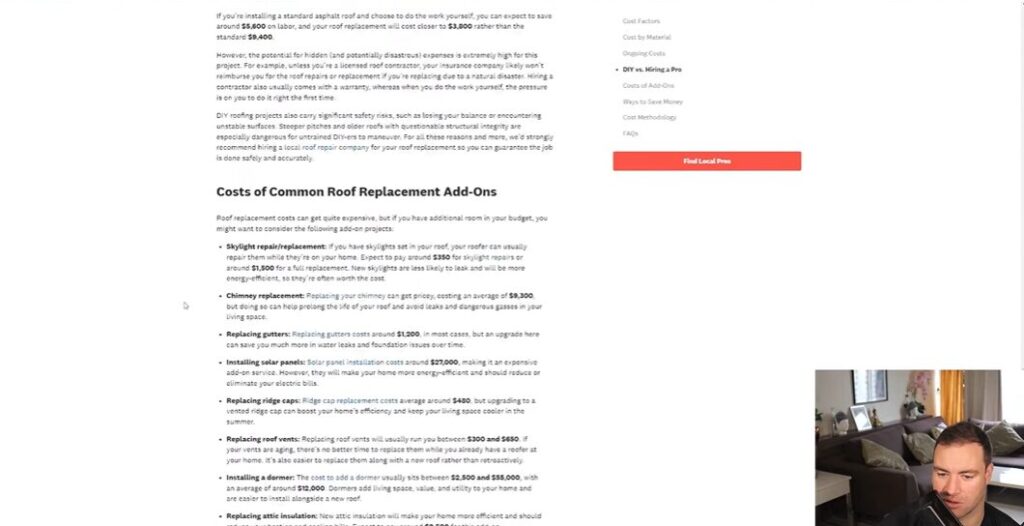
When it comes to blogging, selecting the right topic and keywords is crucial. It can be the difference between your post going viral or being buried on page ten of search results. So how do we identify topics with high search volume? Let's break it down.
First, think about what people want to read. This is often a mix of trends and data. Start by asking yourself:
Tools like Google Trends can be super helpful here. They allow you to see what topics are hot right now. By examining search behavior, we can catch the wave before it breaks.
Next, think about employing reputable tools for keyword research. I often lean on SEMrush. This platform helps me dig deep into what keywords are performing well. It’s not just about finding a list of words; it’s about understanding intent behind searches.
"Input broad topics into SEMrush and discover questions with high search volumes." – Ronald Osborne
For example, if I’m writing about digital marketing trends, I might input "digital marketing" and look for associated queries like "latest digital marketing strategies" or "best digital marketing tools." This not only helps identify keywords but also aids in uncovering potential topic ideas.
Additionally, I always examine the referring domains associated with these keywords. A high count of backlinks can indicate a topic that holds significant interest. But remember, it's about quality, not quantity! One strong backlink from a relevant site is worth more than dozens from lesser-known sources.
Finally, it’s essential to select a topic that aligns with your niche. If your blog focuses on health, writing about car repairs might not resonate well. It’s about finding that sweet spot between popular topics and your expertise.
When crafting content, I often ask myself:
By ensuring alignment, we not only attract traffic but also retain readers. They’ll keep returning for the quality insights you provide in your area of passion.
In the end, it’s all about a methodical approach. With the right topics and keywords under our belt, we can create content that shines, engages, and most importantly, ranks!
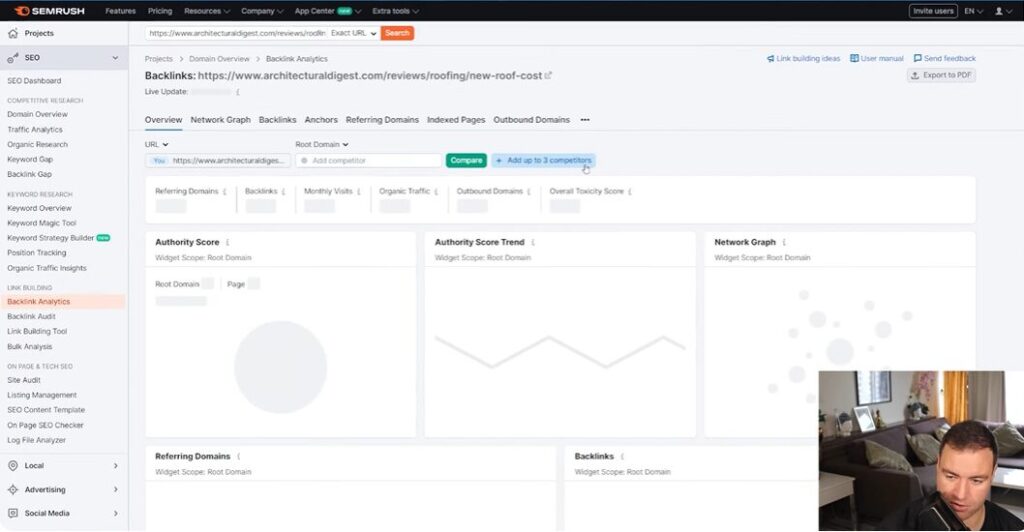
When I think about what makes content 'better', I consider a few key elements. Quality is paramount. But what does quality mean? It’s about providing value—answering questions and solving problems for readers. Everyone loves a good story, right? Engaging narratives draw readers in and make them stay longer.
Have you noticed how some articles seem to bounce right off your screen? They lack the personal touch. That's why I focus on relatability. I remember a time when I stumbled upon an article that simply listed facts. I clicked away quickly. I believe that connecting with your audience through storytelling and relatable examples is essential.
To enhance my content's depth, I often use a strategy I call the skyscraper technique. This involves researching high-ranking articles that already have backlinks and creating something even better. It’s like taking a beloved classic and adding new insights, data, or personal anecdotes.
Using tools like SEMrush helps me discover popular topics and questions. It’s all about understanding what people are searching for. I'm curious: Would you prefer a detailed article backed by statistics or a quick overview? Most lean towards the detailed approach, and that’s why I provide comprehensive coverage, diving into specifics that others might miss, like regional data or updated statistics.
When crafting a detailed article, I start by outlining the key points. What do I want to say? What insights can I add? I create sections filled with rich, informative content. This involves going beyond the surface, tackling common questions, and providing fresh perspectives.
It's essential to have a unique angle. For instance, let’s say the topic is about "How to Start a Garden." Instead of the typical guidance, I’d explore specific plants suited for different climates or share personal experiences from my own gardening adventures.
"Content should not just inform, but inspire and engage." - Ron from Ausborn Digital Marketing
After crafting my piece, outreach becomes crucial. Connecting with webmasters linking to similar content can build valuable backlinks. I emphasize why my article offers more value. It's not just about asking for a link; it’s about creating a compelling reason for them to link back to my superior, detailed work.
Overall, by focusing on quality, depth, and engagement, I see a significant difference in the results. Quality content is what will attract backlinks, turning casual readers into loyal followers.
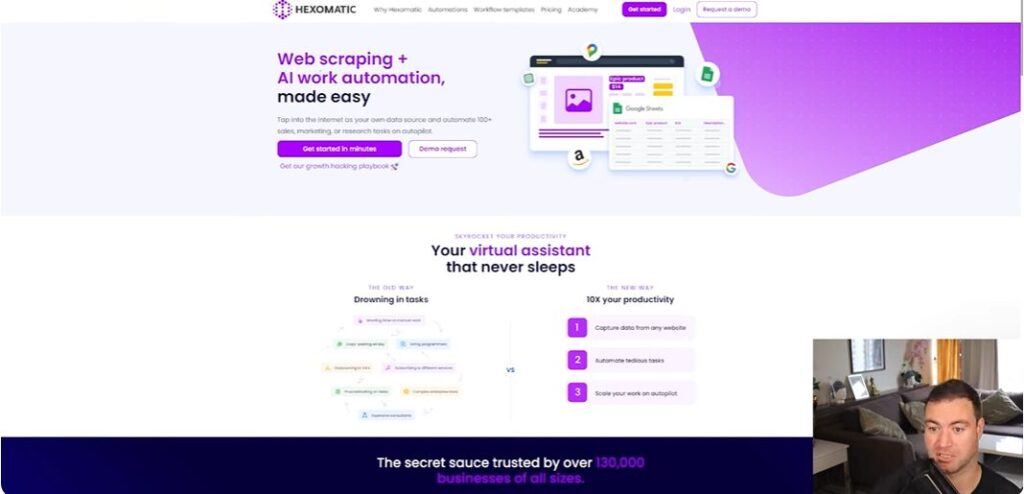
Backlinking is a vital aspect of SEO. Yet, effective outreach can be challenging. I’ve learned some straightforward strategies that make this process more manageable. Here, I’ll share insights on identifying websites that link to your competitors, crafting effective outreach emails, and personalizing your approach to improve response rates. This is factor that is an essential part of the skyscraper backlink strategy guide.
How do you find out who’s linking to your competitors? It’s simpler than you might think. You can use tools like SEMrush or Ahrefs to search for backlinks to your competitor's most popular content. This step is crucial. By understanding where others are getting their links, we can target similar websites.
Here’s a quick checklist for identifying backlink sources:
As Ron from Ausborn Digital Marketing mentions, “an essential part of the approach is making sure the content developed is not only better but distinctly more informative than what’s currently ranked.” I couldn't agree more. This insight drives most of my backlink research, focusing on gaps where I can provide additional value.
What makes a great outreach email? Well, it’s all about clarity and value. When I sit down to craft an email, I aim for a mix of concise language and engaging content. Here’s a simple structure:
For example, instead of saying, “Can you link to my article?” craft your message like, “I noticed your article on roofing tips, and I believe my comprehensive guide could offer more insights for your readers.” This small shift can make a big difference!
Personalization is key. When outreach becomes too generic, it’s easy for recipients to ignore your email. One way I personalize my emails is by mentioning specific details from their site. Perhaps I compliment a recent article or relate to the struggles they discuss. This approach not only builds rapport but makes my request feel more genuine.
Another strategy is to give a reason for your outreach. For instance, if your article covers a topic they discussed, let them know. “I enjoyed your piece on energy-efficient roofing. I've recently published research that complements your insights.” This connection increases the chances of a positive response.
Ultimately, outreach is about nurturing relationships. By investing time in personalization, we enhance our chances of getting those all-important backlinks. Remember, even if you only hear back from one out of ten emails, that one connection can sometimes lead to multiple opportunities down the line.
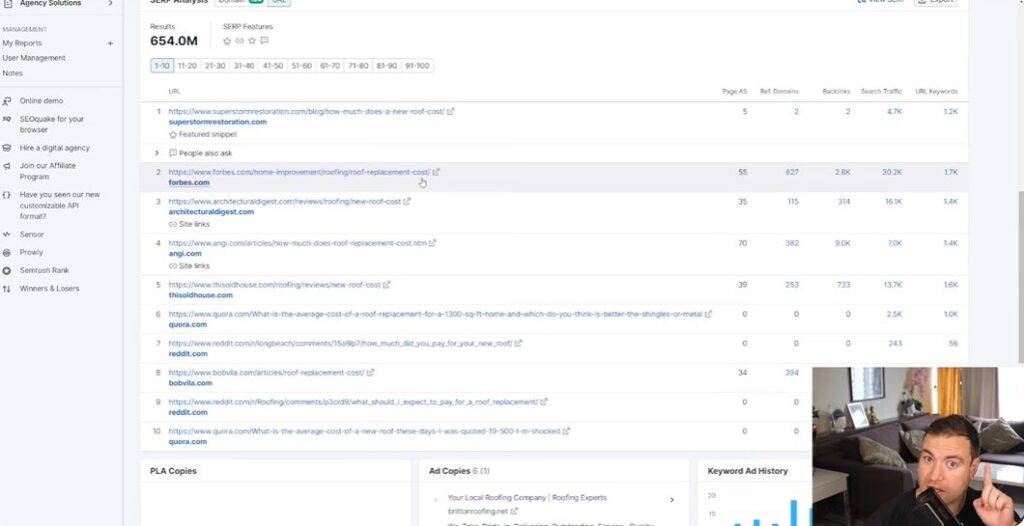
The skyscraper technique is a popular strategy in the SEO world. It’s designed to boost your backlink profile by creating superior content. But is it worth the effort? Let’s dive into the pros and cons.
One of the main advantages of the skyscraper technique is its simplicity. The process is straightforward: find high-ranking content, create better content, and push for backlinks. It sounds easy, right?
Effectiveness is another key factor. If done right, this technique can lead to significant increases in backlinks. More backlinks typically mean better SEO, which can drive more traffic to your site. I often think of it as climbing a mountain; you’re not just aiming to reach the top, but to bring others with you on the journey.
While the skyscraper technique is effective, there are challenges we can’t ignore. The SEO landscape is constantly evolving. What worked last year might not work this year. Increased competition in various niches makes it harder to secure backlinks. It's like running a race; the more participants there are, the harder it becomes to finish first.
Another point is that not every site will respond to outreach. I often tell myself to prepare for rejection—it’s part of the game. An outreach conversion rate of around one percent isn't unusual. This can be frustrating. Are we putting in the effort for limited returns?
Older strategies may not deliver the expected results because they often sit on outdated practices. The world of SEO is dynamic, and what once ensured results can quickly become obsolete. Metrics and algorithms change, often without warning. Are we adapting our methods to these changes?
In the case of the skyscraper technique, some might find themselves in a cycle of creating content without adjusting the outreach strategy. If you’re not innovating your approach, then how can you expect to stand out?
In summary, while the skyscraper technique offers a straightforward method for growing your backlink profile, it comes with significant challenges that must be navigated strategically. The evolving SEO environment necessitates continuous learning and adaptation. And remember, in SEO, what worked yesterday may not work today. It’s vital to keep pushing boundaries and finding the best path forward.
As we come to the end of our exploration of the skyscraper strategy, I want to take a moment to recap the key steps involved in this effective technique. First and foremost, the skyscraper approach is all about finding high-ranking content that has already attracted plenty of backlinks. Think of it as seeking inspiration from content that has already proven itself successful in your niche.
Once you identify that prime content, the next step is to create something even better. This doesn’t just mean longer articles—it means richer content. Adding unique insights, specific data, and updated information can set your piece apart. For instance, I talked about crafting a comprehensive article on “How Much Does a Roof Replacement Cost in South Florida?” that dives deep into regional specifics. This not only attracts attention but also positions you as a reputable source in your field.
Now, you might be wondering, can this technique work across different niches? Absolutely! Whether you’re in real estate, cooking, or tech, the skyscraper strategy can be adapted to fit any topic. It encourages creativity and research, prompting you to find content that resonates with your audience and improves upon it.
This method can be quite powerful for any digital marketer aspiring to enhance their SEO results. Remember, knowledge is no longer just power; it's your path to building real, measurable backlinks. And yes, while the competition is fierce, the impact of creating high-quality content remains unmatched.
Moreover, I’d love to hear from you. What backlink strategies have you been implementing? Engaging in conversations about our methods amplifies our knowledge collectively. A community discussing backlinking can lead to innovative approaches and enhanced success.
In conclusion, while this skyscraper backlink strategy guide isn’t a foolproof strategy and has its challenges, its straightforward nature makes it accessible to anyone willing to put in the work. By focusing on creating unique, valuable content, aligning it with your audience’s needs, and executing proper outreach, you can effectively build those crucial backlinks. Let’s make it work for us. Thank you for joining me on this journey, and I look forward to hearing about your successes in the comments or through social media! Let’s keep the conversation going and inspire each other.
Have you ever felt overwhelmed by the intricacies of local SEO? I certainly have! A few years back, my journey took an unexpected turn when I stumbled upon topical maps – a game-changer for local businesses. Today, I’m going to share with you the secrets on how to create a topical map for local SEO that has been a cornerstone of my business success.
TL;DR: Learn how to create an effective topical map for local SEO, using tree removal as a real-world example, complete with AI prompts, keyword strategies, and linking structures to boost your online presence.
When it comes to local SEO, have you ever considered how well you cover a topic? Let’s dive into what a topical map is and why it matters.
In simple terms, a topical map is a tool we use to organize information about a specific subject - think of it as your roadmap to SEO success. It’s all about connecting the dots within a topic.
So, what does this look like in practice? For instance, if we focus on “tree removal,” a topical map will cover everything related to that topic. This includes:
Essentially, we are compiling a comprehensive view of the subject, which is crucial in today’s SEO game.
Now, we need to address the importance of comprehensiveness. Why is it so vital? Think about it: search engines like Google are looking for quality. They want to provide users with the most relevant and informative answers. If your content lacks depth, you're likely to be overlooked.
Covering a topic thoroughly means:
By mapping out your topic in detail, you set yourself up as an expert. Do you want to be known as a jack-of-all-trades or a master of one? I know which one I’d choose.
Let’s switch gears a bit. Traditional SEO often focuses on optimizing individual pages for specific keywords. While this approach has its merits, it can sometimes lead to fragmented content. In contrast, topical maps emphasize a holistic view of your subject.
Instead of isolating keywords, we connect them. Why is this beneficial? Because it creates a network of related information that search engines love! By organizing content into silos, we facilitate better internal linking, which strengthens our overall strategy.
Picture it this way: if your website is a tree, then your topical map is the root system. The stronger and deeper the roots, the taller your tree can grow.
Let’s bring this down to earth with an example. Imagine you’re running a tree removal service in Miami. What would a topical map look like for this scenario?
By structuring your website like this, the internal linking between these subtopics and supportive posts enhances your site’s authority on tree removal in that area. Each piece of content serves a purpose and beckons potential customers to explore more.
Have you noticed the difference a topical approach can make? I can assure you, the results can be remarkable.

Creating a topical map can feel overwhelming at first. But I assure you, it’s a powerful tool for boosting your local SEO. I’ve been using this technique for a while, and it’s been very effective in achieving consistent success - for me, about ninety percent of the time! Here’s a simple step-by-step guide to get you started.
First off, we need to identify our primary subject. For instance, let’s focus on tree removal. This is not just any tree removal; it’s a local service. We’re talking about areas like Miami or Fort Lauderdale. Understanding your core topic is essential because everything else will revolve around it.
Once we have our main topic, it's time to find relevant subtopics. Consider different angles or aspects of tree removal. Some ideas might include:
These subtopics help flesh out the broader subject and demonstrate expertise. Think of your main topic as a tree itself, with its branches representing subtopics.
This is where we can leverage technology for efficiency. AI tools can generate content ideas and questions related to tree removal. For instance, I often use prompts to uncover what potential customers might ask:
“What are the signs that my tree needs removal?”
Using AI to create these prompts saves time. Plus, you’re tapping into actual queries people are searching for. Why guess when you can know?
Now that we have our main topic and subtopics, it's time to organize them hierarchically. Start with your primary subject at the top: tree removal.
Next, layer on location-based pages. For example, the next tier might be “tree removal Miami” or “tree removal Fort Lauderdale.” Support these with blog posts that cover related topics. This structure allows search engines to see the relationship between them, which can enhance your authority.
Content creation is crucial. I'll often write several blogs that support the main topic and those specific services. Utilizing good internal linking strategies allows your content to interconnect effectively. Think about how you'd structure a web of conversations about tree removal.
Remember: It's not enough to have just location and service pages. You need engaging, valuable content that enhances the topic. The better the content, the higher the chance of ranking well in search results.
Let’s get practical. Here’s an example of a topical map for Miami tree removal:
This structure provides a clear path for content generation and ensures that visitors can navigate through topics easily.
Building a topical map may seem like a lengthy process at the start, but the results speak for themselves. A well-organized topical map can establish your site as the authority on a subject, especially in local SEO.
So, let’s get started on your journey to SEO success!
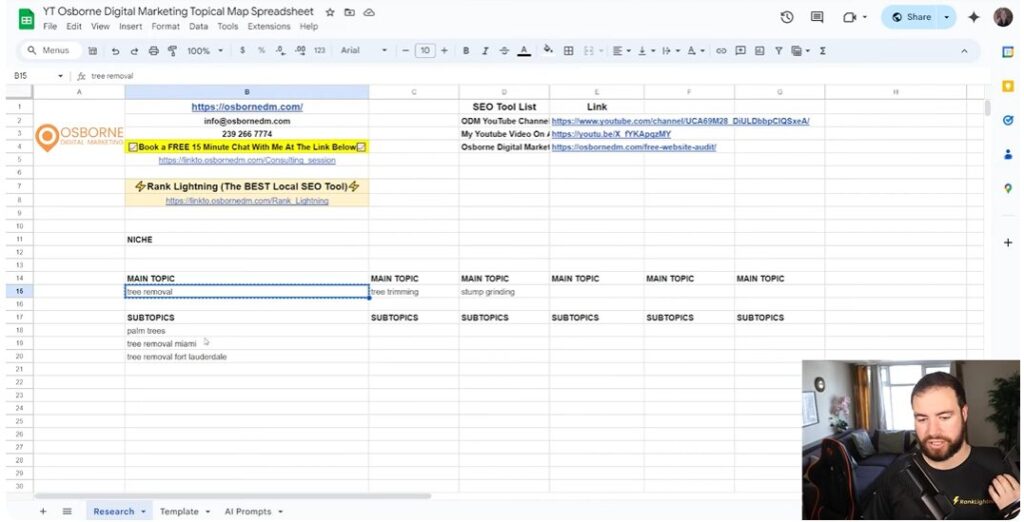
When diving into local SEO, one of the most important tasks is conducting keyword research. As I jump into this, I think about what my audience is looking for. What terms are they using? This is particularly critical for local businesses. For instance, if you're in Miami and want to do tree removal, the keywords you select can significantly impact your online presence. Let's break down the essentials of this process.
First off, let’s talk about tools. There are many options available, from free ones like Google Keyword Planner to advanced paid tools like Ahrefs or SEMrush. Why are these tools crucial? They help us discover what people are actually searching for in our area. For example, you might think that “tree removal” is your only keyword. But when I’ve analyzed data, I find that terms like “emergency tree removal Miami” or “affordable tree services in Miami” could be far more beneficial for attracting local customers.
After discovering potential keywords, the next step is assessing their volume and competition. Here’s where we separate the wheat from the chaff. High-volume keywords are great, but if they're too competitive, you might struggle to rank. It’s like trying to compete in a race against Usain Bolt. Who stands a chance? Instead, I usually look for keywords that have decent volume but lower to moderate competition. These are often easier to rank for.
Imagine this scenario: you find a keyword like “tree removal services for palm trees Miami.” It may not have thousands of searches, but if the competition is low, you stand a chance of ranking quickly. Using tools like Google Trends can show you how interest in a keyword changes over time. This is valuable information, especially if you’re trying to capitalize on seasonal trends.
Another vital tactic in your keyword research journey is incorporating long-tail keywords. Long-tail keywords are phrases typically three or more words long. They are more specific, and often, they attract customers who have a clear intent. For example, someone searching for “cheap tree removal in Coral Gables” is likely ready to hire a service, unlike those who only search for “tree removal.” This specificity can lead to higher conversion rates.
Similarly, geographic targeting is a must for local SEO. Think about your ideal customer. Are they local? Then incorporate geographic terms into your keywords. I often advise people to make a list of specific neighborhoods or landmarks around their business location. For example:
By using these geographic identifiers, you signal to search engines that your business is relevant to local queries.
To help visualize this, let's look at an example related to tree removal keywords in Miami:
These specific keywords not only convey the services offered but also target the right geographical area. Why does this matter? Because customers look for local businesses, and when they find yours, they are more likely to consider reaching out. When I created my topical map, targeting relevant keywords led to remarkable visibility for my SEO efforts.
While this process might seem daunting at first, remember it’s about gradual growth. With each search query, we’re one step closer to understanding our audience and meeting their needs.

When I was first delving into the world of SEO, it felt overwhelming. So many strategies, so many ideas. One stands out: creating an effective content structure. In particular, internal linking and topical maps have changed the game for me. Let’s break this down and see how it can work for you. After all, I want to share what’s worked for me in a way that’s straightforward and easy to digest.
So, what’s the deal with internal linking within topical maps? I believe that internal links are the roads that connect your content. They guide users - and search engines - through your website. When you create a topical map, every subtopic should interlink with your primary topic and each other. This helps establish a network of related content. It can also clarify your site’s hierarchy.
I can’t stress this enough: A clear internal structure is crucial. Imagine entering a warehouse filled with products, but everything is jumbled. Confusing, right? That’s how users feel when navigating a poorly structured site. So, here are some tips to maintain clarity:
Here’s a question: How does your internal structure look right now? If you’re feeling unsure, revisit your site’s layout. Look for areas that need improvement.
Next up is the visual arrangement of your content. Visuals play a huge role in how users interact with your site, and they can aid in SEO too! You might wonder, why should I care about visuals? Let me tell you - it enhances user experience, and in turn, keeps visitors on your site longer.
Consider this:
As I figured out these strategies, I never looked back. Properly structuring my content with a focus on internal linking, clarity, and visual appeal has propelled my SEO efforts. Remember, it’s not just about creating content; it’s about crafting a journey for your users. When they navigate easily and find value, search engines will notice too.

When I think about blogs, the words support and authority come to mind. A well-structured blog can act as the foundation for your main topics. Think of it as the backbone of your website.
In today's digital landscape, most people rely on blogs to find information. They serve as a way to engage with your audience and establish yourself as an authority in your niche. Effective blogging can lead to improved website rankings, increased traffic, and, ultimately, more business inquiries.
But why are blogs so crucial? Well, they offer a unique opportunity to dive deeper into the subjects that matter to your audience. They allow you to explore topics related to your primary services, like “tree removal,” while providing valuable context and insights.
Let’s face it: not all content is created equal. The key to dominating your niche lies in creating valuable and relevant content. We're talking about content that resonates with your audience. It's not enough to shove keywords into a post. You need to offer real value. But how do we do this?
As Ronald Osborne eloquently states, “An effective topical map will include everything you need to know about the subject, including subtopics.” This means exploring closely related topics can help enhance your main content significantly.
Local authority is something every business should strive for. It’s not just about being recognized in the online space; it’s about being trusted in your community. Here are some strategies to enhance your local authority:
But remember, it’s not about the quantity of content; it’s about the quality. Writing multiple blogs to support your main topic can significantly improve your search authority. Regularly publishing content also shows search engines that your site is active and relevant.
Establishing authority with supporting content is an ongoing journey. By creating relevant blogs and examining local concerns, we become a trusted resource for our community. I encourage you to engage, share your insights, and utilize your blogs as a vehicle for establishing your authority. Embrace the process and don’t hesitate to invest time in understanding your audience’s needs. That's where the magic happens.

Creating an internal linking strategy for your topic map pages is crucial. It’s like connecting the dots in a picture. It is an essential part as you learn how to create a topical map for local SEO. Each dot, or page, needs to be linked so that visitors (and search engines) can easily navigate your site. In this guide, I'll show you how I approach internal linking for my topic maps, drawing from my SEO experiences and strategies.
What exactly is internal linking? Simply put, it’s linking one page of your website to another page on the same site. This helps distribute page authority and encourages visitors to spend more time exploring. It's about creating a logical flow of information.
When I create a topic map, I start by identifying my main topic. For instance, if the main topic is "tree removal," I’ll break it down into subtopics and relevant geographical locations such as "tree removal Miami" and "tree removal Fort Lauderdale."
Now, how do I structure this? Think of it like a pyramid:
Every subtopic and geolocation page must link back to the main topic page. This creates an effective internal linking structure.
Having just the service pages isn’t enough. It’s essential to produce supportive content that covers various aspects of the topic. For instance, alongside "tree removal," I might write blogs like:
These blog posts should all link back to the main “tree removal” page. This not only provides context but also enhances your site’s authority.
To write content that resonates with search intent, I often use SEO tools for keyword research. You can use tools like Ahrefs, SEMrush, or even free options like Google Keyword Planner.
After identifying relevant keywords, craft your content around them. Why? Because these keywords are what potential customers are searching for. This strategy ensures that the content you create is not just good for SEO but also valuable for your audience.
When working on your internal linking strategy, always remember to keep your links within topical silos. This means that links should only connect relevant topics. It avoids confusion for search engines and enhances user experience. Think of it like organizing files in a cabinet; it’s much easier to find what you need when everything is grouped logically.
Lastly, after implementing an internal linking strategy, I recommend monitoring its performance. Use tools like Google Analytics to track the behavior of your site visitors. Are they clicking on the internal links? Where are they spending most of their time? This information will guide you in optimizing your linking further.
Remember, SEO is a journey, not a sprint. By ensuring that your internal linking strategy is strong, you’re laying a solid foundation for your content. It may take time to see results, but stick with it. Consistency is key to effective SEO!

When we talk about monitoring performance in the realm of SEO, it’s crucial to understand what elements to track. A detailed approach is vital, particularly when you're working with topical maps. These structured blueprints need ongoing attention to ensure they're providing the expected results. Let’s dive into how I tackle this challenge.
First, let me say that the right tools can make a world of difference. Think of them as your GPS for navigating the SEO landscape. They guide you through the often confusing terrain of data and analytics. Here are some of my go-to tools:
But these tools are just the start. Once I gather data, I need to analyze it. That’s where the real magic happens. How do I iterate from what I find?
After tracking performance, I move to the analytics phase. I look for patterns. Is a specific subtopic exceeding expectations? Or perhaps another isn't delivering traffic at all? If I notice that “tree removal Miami” performs well but the page on “tree removal for palm trees” isn't, it’s time to act.
I’ll delve deeper. What about the good-performing pages makes users stay? Maybe it’s the length of the articles, the images used, or perhaps the internal links? I always ask myself:
Moreover, I’m never afraid to experiment, to try new formats, or to change the headlines. In SEO, stagnation is the enemy. By reviewing my analytics regularly, I ensure my map stays relevant and effective.
Adjusting keyword strategies based on performance metrics is where the rubber meets the road. Imagine trying to navigate a city without street names. That’s what working without solid keyword data feels like!
If I see that certain keywords are driving substantial traffic, I delve deeper. Perhaps I can expand those sections or create additional content based on related queries. Often, I highlight:
And here’s a key insight: performance isn’t just about monitoring. It's about adapting. As I adjust my strategies based on the metrics I observe, I’m not just keeping pace with changes; I’m often stepping ahead. This proactive approach allows me to stay relevant in the ever-evolving world of SEO.
“SEO is not a one-time task but a continuous journey of analysis and improvement.”
Each time I make adjustments, I’m reminded of the power of iteration. Platforms change, algorithms evolve, but the need for well-structured, relevant content remains constant. That's the foundation of any successful SEO approach.
The more intensely I track, analyze, and adjust, the better positioned I am to navigate the complexities of search engines and user habits. It’s a dance - one that requires attention and finesse.
As we learn more about how to create a topical map for local SEO, I can't help but notice some common pitfalls that many fall into when implementing topical maps. Having been there myself, I understand how daunting it can be. However, avoiding these mistakes can make a huge difference in your success. Let’s explore some key areas where many stumble and how we can circumvent these traps.
The first mistake is often neglecting research. I know research can feel tedious, but trust me, it’s crucial. Take time to identify your main topic and its subtopics. For example, if you're focusing on “tree removal,” you need to consider subtopics like “tree trimming,” or “hazardous tree removal.” Missing out on these details can cause gaps in your content.
Another major pitfall is ignoring the importance of keyword volume. If you’re tempted to create pages on topics nobody is searching for, you’re wasting your time. I’ve been there! It’s frustrating to see all that effort go unnoticed. Use tools to check the search volume on your keywords before diving in.
Lastly, a common oversight is failing to structure your topical map effectively. A chaotic structure translates into a confusing experience for both users and search engines. Instead, I recommend a hierarchical layout, starting with the primary topic and moving down to specific services and locations. This way, you maintain clarity and relevance.
I often find that overcomplicating your strategy can lead to disaster. When I first began, I was tempted to include every possible subtopic without thinking critically. The result? A diluted message that did nothing for my SEO. Instead of trying to cover everything, consider focusing on a few topics that you can delve into deeply. Depth over breadth should be our mantra here.
Moreover, have you ever tried to explain something complex to a child? The key is simplicity. By overcomplicating your strategy, you risk alienating your audience. Keep it straightforward. Dive deeper into a few areas, and your audience will thank you for the clarity.
When it comes to content, I believe it’s essential to emphasize quality over quantity. Sure, churning out numerous blog posts might seem appealing at first. But they won’t do much good if they’re filled with fluff! Invest your time in producing high-quality content that provides genuine value to your readers. It’s more beneficial to create fewer, more thorough articles than to post daily with mediocre content.
One strategy I find effective is using AI tools effectively. They can be incredibly helpful in generating ideas or content, but I don’t rely solely on them for high-importance pages. You want to ensure that your content meets your standards and resonates with your audience. This is where I urge you to maintain control.
At the end of the day, the internet is flooded with content. Why would anyone stop and read yours? It’s simple: your content must stand out. Aim to provide depth, insight, and unique perspectives. This will not only aid in ranking but also in forging a connection with your audience.
In conclusion, by avoiding common mistakes, simplifying our strategies, and focusing on the quality of our content, we can build a more effective topical map. It's not just about putting information out there - it's about creating a valuable resource that people will want to engage with. Remember, SEO is a marathon, not a sprint. With persistence and a clear focus, we can achieve substantial success in our endeavors.
If you have any further questions or are looking for additional insights, feel free to drop a comment below! I’m here to help.
Let me take you back to my early days in my journey as a digital marketing agency when I stumbled upon the power of SEO forecasting. It wasn’t just about keywords; it was about understanding the potential revenue from my SEO efforts. Armed with Google Sheets and a custom tool I created, I uncovered strategies that changed the way I approached local businesses. In this article, we will learn how to forecast SEO growth.
TL;DR: You can use SEO forecasting tools like Google Sheets to estimate revenue and determine the ROI for local SEO efforts. This guide shares insights and charts to help visualize and understand the process effectively.
In today’s digital realm, SEO isn’t just another marketing strategy - it's crucial for business survival. Why, you ask? Well, developing a strong SEO forecast helps businesses identify potential return on investment (ROI). This isn't about guesswork. It's about informed decisions. With the rising complexities and costs associated with SEO, adopting a clear forecasting method gives your business a competitive edge.
When I first paved my way into SEO forecasting, I was surprised by its importance. The landscape has changed. Back in the day, getting to the top of search results was straightforward and relatively cheap. But not anymore! Now, it demands a strategic approach akin to traditional business investments.
My initial attempt at SEO forecasting was like diving into uncharted waters. At first, I floundered. I learned quickly that utilizing tools and frameworks is key. I created a Google Sheets template that streamlined the process immensely. I remember thinking, “How did I manage without this?” These sheets allow for the input of vital metrics, including conversion rates, backlink costs, average transaction values, and potential conversions.
One important lesson? Always start with conservative estimates. For instance, I chose the keyword “Roofing Miami” to demonstrate how to input data effectively. Through this exercise, I realized that understanding competitor metrics through API was essential. Analyzing factors like the number of reviews and referring domains sharpened my focus on what’s realistic, and honestly, it felt empowering.
Many treat SEO as a side project or hobby. This approach is a huge mistake. SEO is as serious as any other business investment. Take it from me; if you want to see real results, you need to treat it that way. Imagine investing \$10,000 into SEO, but your potential earnings soar to $80,000. Indeed, SEO is an essential part of business growth. That’s a no-brainer!
By forecasting, we gauge the weight of our investments. Tools like the spreadsheet I designed help businesses visualize costs against potential income. It’s all about establishing that clear understanding, and that’s what encourages healthy discussions with stakeholders. I believe that with every forecast, you’re equipping yourself with the data necessary to advocate for your SEO initiatives. Don’t skimp on this step!
In doing this, we create a foundation on which realistic expectations can be set. Remember, SEO can seem daunting, but breaking down complex calculations into bite-sized bits makes it manageable. I can testify, understanding the average transaction value (often around $7,500 for roofing companies) allows for accurate potential return assessments.
If you take SEO forecasting seriously from the get-go, you're building a roadmap towards effective and strategic decision-making.
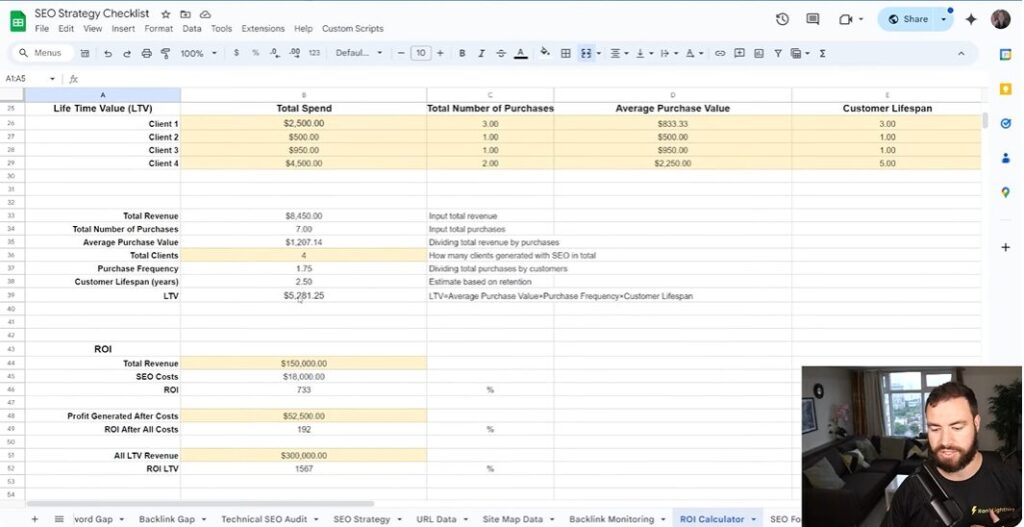
When considering SEO services, Google Sheets can be a game changer. I’ve found it incredibly useful for organizing data, forecasting, and tracking key performance indicators. Here you can organize information pertaining to website traffic, keyword performance, and such. So, let’s break it down. Here’s how to set up your spreadsheet for maximum impact.
First things first: your spreadsheet needs to be accessible. Whether you’re working with a team or solo, setting up a public or shared Google Sheet is crucial. This way, everyone can contribute or view the data. Think of it like a communal garden. Everyone adds their own touch, and when well cared for, it grows beautifully.
Now, what should you be focusing on? With SEO, there’s a lot of data to sift through. I suggest honing in on these metrics:
The way you input information can make or break your analysis. Keep these tips in mind:
As I always say, “We can't have a sound SEO strategy without understanding the data behind it.”
By utilizing Google Sheets for data organization, you can not only track your progress but also forecast future performance effectively. You can easily understand and analyze important information such as organic traffic, keyword rankings, and more.

When you want to improve your local SEO, one of the first things I consider is search volume. What does this number even mean? Simply put, it shows how many times a particular keyword is searched in a specific period. For instance, if the keyword "Roofing Miami" has a search volume of 1,000, it means people are actively looking for roofing services. High volumes of traffic can indicate strong demand, but they don't tell the whole story.
Next, we must examine rankings. What's the point of having a high search volume if my website isn’t ranking in the top results? I strive to be among the first three listings in search engines. Some experts implement strategies to boost rankings through increasing organic traffic to a SaaS website. According to recent studies, about 75% of users don’t scroll past the first page. This is why understanding not just volume, but where I rank for relevant keywords matters significantly.
Now, this is where things can get tricky. I remember when I first started understanding metrics. I often confused average with median. Average simply adds up all the numbers and divides by the total. If there’s one extreme high or low value, it skews the average dramatically.
On the other hand, the median is the middle value. It’s much more reliable when comparing things like the number of reviews. If one competitor has 1,000 reviews, while others have 10, the average can be misleading. Instead, focusing on the median gives me a clearer picture of what’s typical in my industry.
Let me share a little story. Early in my SEO journey, I overlooked the importance of search volume and ranking. I thought, “I have a beautiful website. It’ll naturally rank!” Boy, was I wrong. My site barely saw any website traffic!
After tons of research and a lot of trial and error, I learned to analyze my keywords, metrics, and the competition. Only then did I start seeing results. This journey taught me that understanding key metrics is not just beneficial; it’s essential for success in local SEO.
Predicting organic traffic for your website is essential for creating effective SEO plans and strategies. By examining historical data, analytics, and current trends, businesses can uncover insights into potential traffic patterns, which helps them make informed choices about content creation, keyword search, and overall marketing efforts. Data such as keyword performance, traffic analysis, and rankings are important. Understanding these forecasts allows organizations to allocate resources more effectively and focus on initiatives that are likely to deliver the best returns in terms of visibility in search engine results and engagement.
The ability to predict organic traffic not only helps in optimizing existing content but also significantly influences future SEO strategies. By pinpointing which topics and keywords are expected to draw more traffic and visitors, companies can customize their content development to match user interests and search behaviors. This proactive strategy ensures that businesses stay competitive in their markets, enabling them to quickly adapt to changes in search engine algorithms and consumer preferences.
Moreover, forecasting organic traffic of your website can improve the overall success of an SEO campaign by establishing measurable goals and benchmarks. By setting realistic expectations based on analytics and data-driven insights, organizations can monitor their progress and make necessary adjustments to their strategies. This ongoing process encourages continuous improvement, ultimately resulting in greater organic visibility, higher conversion rates, top rank in search engines, and a more robust online presence.
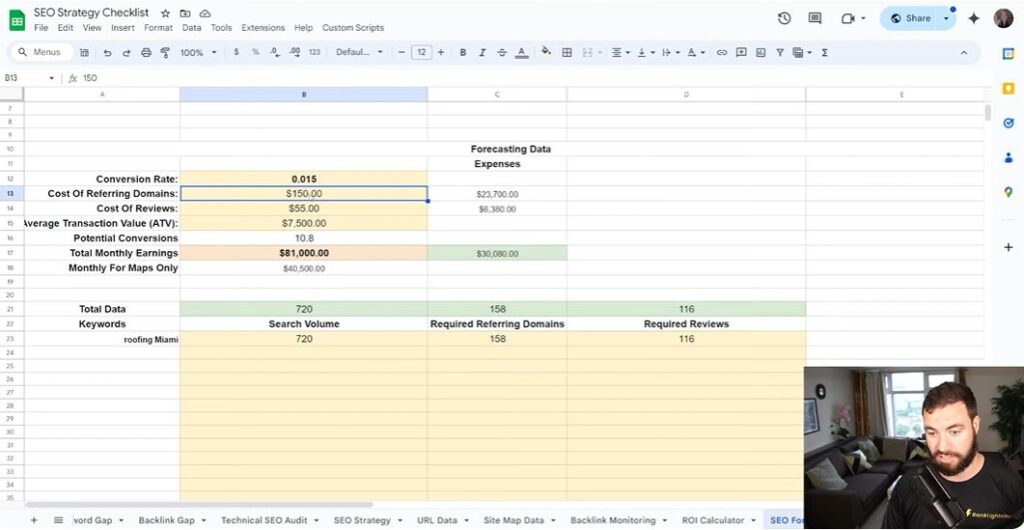
When we dive into the world of SEO, the first thing we notice is a critical question: What are the actual costs? I often find myself breaking down the investments in two primary areas: referring domains and reviews.
So, what’s the bottom line? Every investment you make in domains and reviews should be viewed through the lens of potential returns. If you spend $1,000 on a reputable referring domain, but it boosts your site's organic traffic by 30%, that’s a win!
Now, let’s talk about ethics when it comes to obtaining reviews. Have you ever been tempted to buy reviews? Here’s the reality: It can be risky. The market is filled with offers to sell fake reviews. But this can backfire.
“Integrity is doing the right thing, even when no one is watching.” – C.S. Lewis
It’s essential to build a strategy that values honesty. Seek authentic reviews by engaging with your customers post-purchase. This may require effort, but the results are far more rewarding. Genuine reviews foster trust.
I can’t stress how invaluable tools can be in this process. For instance, my go-to resources include:
Ahrefs – Great for checking referring domains in your niche.SEMrush – A fantastic tool to gauge market competitors and their review strategies.Google Sheets – Use this lightweight spreadsheet to keep track of your investments vs. returns.With these tools in hand, we can get a snapshot of where we stand and make informed decisions. It’s all about making your budget work for you and ensuring your SEO efforts are both strategic and effective.

When it comes to forecasting your SEO efforts, running your data through a table can be a game changer. So, how to calculate and forecast SEO growth? First, I recommend using a simple Google Sheets template that I created. This tool can help visualize key metrics and make everything easier to digest. With my Rank Lightning tool, we can streamline this entire process.
Here's how you can do it:
Once these metrics are in place, you can see a clear picture of potential returns on your SEO investment. For instance, let's say we're focusing on the keyword “Roofing Miami.” By entering relevant data, we'll get insights into whether our SEO efforts are really worth it.
Another important aspect is understanding how to manage our expectations. It's easy to get carried away with potential outcomes. We need to be realistic. A conservative average conversion rate of 1.5% for local businesses, although minimal, provides a cushion for realistically gauging lead generation effectiveness.
Ask yourself, what happens if we don't hit that 1.5%? Knowing the numbers helps you make informed decisions.
Finally, let's talk about data types. Using live data vs. historical data for analysis is crucial. Live data provides real-time insights and analytics, but historical data helps us understand trends over time. How do we strike that balance? I suggest starting with live data for immediate insights, then layering in historical analysis to capture broader trends. This dual approach enriches our understanding of market dynamics.
SEO forecasting uses a data-driven approach to predict how a site will perform in organic search over time. This process involves analyzing both current and past data, such as keyword rankings, organic traffic, click-through rates (CTR), and search volumes, to estimate the number of visitors a website is expected to attract within a specific period.
By incorporating these elements, we can create a thorough SEO forecast. Your business deserves clear analysis, backed by data, leading to informed decisions! It's time to bring clarity to the often murky world of SEO forecasting.

When I think about SEO forecasting, the first thing that comes to mind is clarity. It’s like having a roadmap. But what exactly do we gain from this practice?
As Ron from Osborne Digital Marketing pointed out, a simple Google Sheets template can help with these calculations. You enter essential data like conversion rates, and voilà! You get a rough estimate of the ROI of your SEO efforts.
Now, while forecasting has its perks, it’s important to acknowledge the downsides. Nothing is perfect after all. What are the potential pitfalls?
As with any forecasting or predictive tool, it’s essential to balance optimism and realism. Understanding both the benefits and limitations lets you navigate the SEO landscape more effectively.
Now that we have discussed the basics of SEO Forecasting, let's get an overview of the types of of forecasting that you should have an idea about.
Keyword forecasting is a strategic method that focuses on predicting how specific keywords will perform in SEO and digital marketing. This approach can offer valuable insights into potential traffic, user intent, and market trends, enabling businesses to adjust their content and advertising strategies accordingly. By examining historical information and current search trends, marketers can pinpoint which keywords are likely to become popular, thus optimizing their campaigns for improved visibility and engagement.
However, despite the many benefits of keyword forecasting, it does come with its challenges. A major issue is the unpredictable nature of search behavior, which can be affected by various external factors like seasonality, emerging keyword trends, and shifts in consumer preferences. Furthermore, depending too heavily on forecasting models can lead to overconfidence in the predicted results, which might cause mishandling of resources or missed opportunities if actual performance diverges from expectations.
In summary, keyword forecasting is a valuable tool for enhancing digital marketing efforts for your site, but it requires careful attention to its limitations. Businesses need to balance the insights gained from forecasting with a flexible strategy that allows them to adapt to real-time market changes. By merging data-driven predictions with continuous analysis and responsiveness, organizations can enhance the effectiveness of their keyword strategies while reducing the risks linked to forecasting inaccuracies.
Statistical forecasting has its pros and cons that deserve attention. On the positive side, it leverages historical data to spot trends in site traffic, keyword rankings, and click-through rate (CTR) allowing organizations to make educated predictions about future events. This approach can enhance decision-making and improve resource allocation, ultimately boosting efficiency and effectiveness.
On the flip side, statistical forecasting has its drawbacks. Relying on historical information about a site's performance can lead to inaccuracies if past trends change or if unexpected variables come into play. Moreover, the complexity of statistical models can lead to misinterpretation or overfitting, which may undermine the reliability of the forecasts. Therefore, while statistical forecasting can be a useful tool, it’s important to use it cautiously and be aware of its potential limitations.

Let’s start by addressing a big misconception: many people believe that accumulating reviews alone will instantly boost their site’s ranking. While it’s true that reviews matter, they are just one piece of a larger puzzle. Think of it like a recipe; you need the right mix of ingredients to bake a delicious cake.
In short, while reviews are important, they shouldn't be the sole strategy for improving ranking. It’s about all aspects of SEO working together.
Now, let’s talk about conversion rates. The numbers can be enlightening, yet often misunderstood. You might think, “If I attract more visitors and traffic on my website, sales will naturally increase.” But what if I told you it’s more complicated? Just because organic website traffic spikes doesn’t guarantee conversions.
To illustrate, I suggest a target conversion rate of around 1.5% for local businesses. This isn’t a magical number; it's a conservative estimate. You can derive a lot of insight from understanding your average transaction value (ATV). For example, if your ATV is $7,500 for roofing companies, that small percentage can lead to significant revenue.
Lastly, let’s discuss client expectations regarding SEO. Sometimes, clients expect quick results, forgetting that SEO is a long-term game. Like tending a garden, you may not see blooms overnight.
I’ve found that when clients grasp the complexities involved, they become more supportive of the strategies we propose. It builds trust and leads to collaborative success.
Ultimately, SEO is about striking the right balance. It’s crucial to bust these myths and educate both ourselves and our clients. By doing so, we can navigate the landscape of SEO with confidence and clarity.
As we wrap up your first SEO forecast, I want to emphasize how important this experience has been. Completing your traffic forecast is not just about dollars and cents; it’s about understanding the journey ahead. It requires a lot of analysis and understanding about website traffic analytics, keyword performance, ranking, and more. Remember, each data point you entered was a step towards mastering local SEO. When you learned how to forecast SEO growth for future trends, this is where your business growth can truly begin to flourish.
Now, it’s time for reflection and refinement. You’ve taken a significant step in forecasting the potential return on investment for your SEO efforts, and I encourage you to continue refining your process. Consider this analogy: think of SEO forecasting like honing a sharp blade. The more you practice and adjust your technique, the better the edge you'll have. So don’t shy away from experimenting with your inputs or methods. Are there new metrics you can add? Is there a better way to visualize your data?
Additionally, never underestimate the power of continuous learning. There are numerous resources available that can enhance your understanding of SEO forecasting and local SEO strategies. Websites, forums, and even online courses can vastly improve your knowledge. I invite you to explore communities where professionals share their techniques and tips. Join discussions and seek out mentors; these relationships can provide valuable guidance that might change how you look at SEO altogether.
If you’re looking for tools, my Google Sheets template and Rank Lightning are fantastic resources. They can link you to actionable plans that clarify your strategy. Don’t forget to reach out to me for a free 15-minute consultation if you want to know more about handling ads, PPC, CTR, and backlink gaps. I’m here to help!
In summary, forecast and assess traffic or keyword performance. Refine and learn. These steps will guide you as you continue your local SEO journey. I’m excited to see where your efforts take you! Let’s commit to elevating your SEO success, one forecast at a time.